But search for “how to get customers,” and you’ll find yourself flooded with advice, tips, and tactics. It’s hard to know which one to choose, considering that you have limited resources.
Fortunately, most strategies on how to get customers boil down to these four fundamental methods:
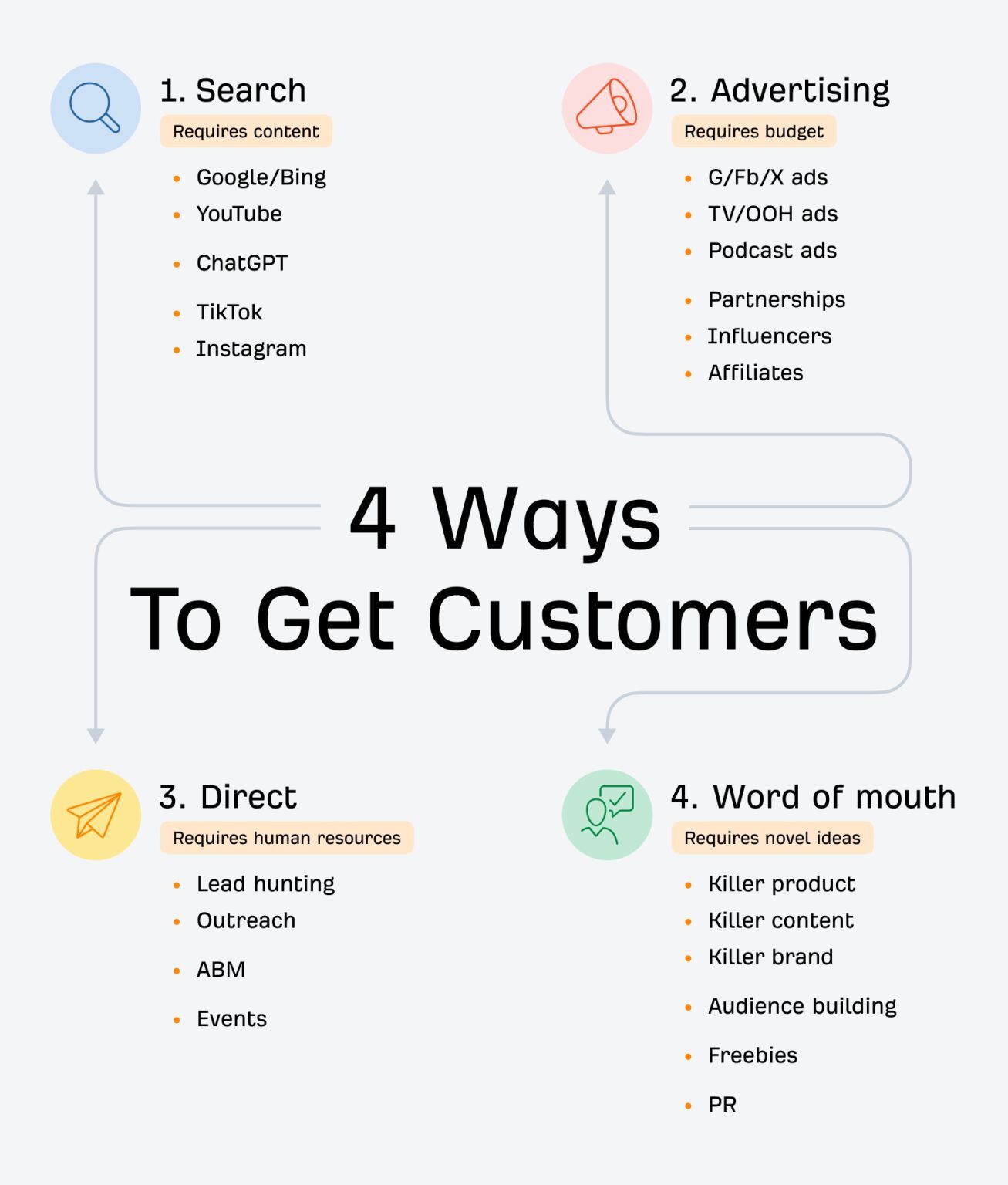
Find out what your customers are searching for, where they’re searching for it, and show up with your content.
Here are the major search channels:
Google and Bing
If you want to rank high on search engines like Google and Bing, you’ll have to target topics your audience is searching for.
The easiest way to begin is to use a keyword research tool like Keywords Explorer. Here’s how:
- Go to Keywords Explorer
- Enter terms relevant to your website or niche
- Go to Matching terms
For example, if you own an ecommerce store selling coffee equipment, you’ll want to add words like “coffee”, “french press”, and “latte”.
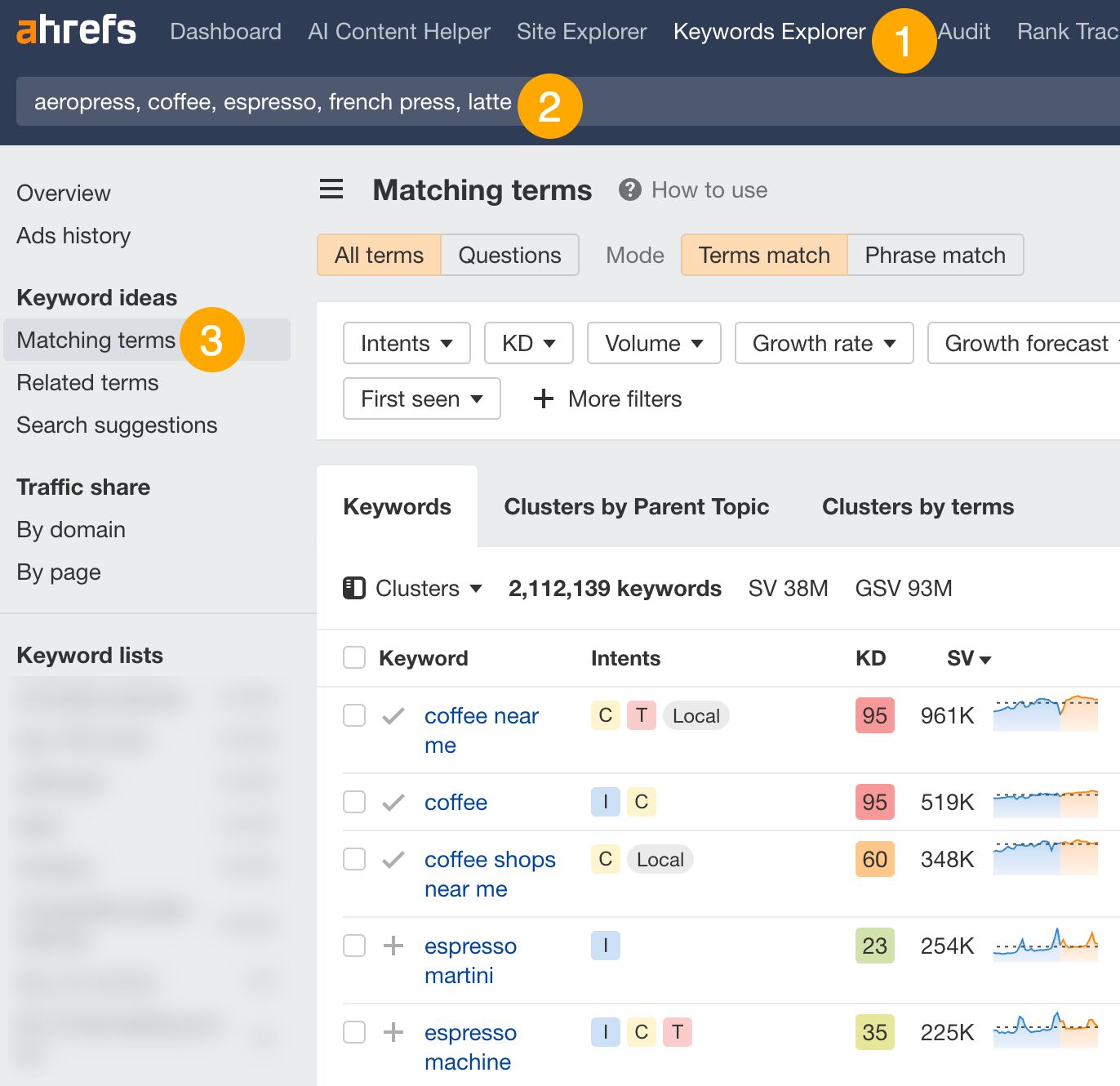
From here, you’ll want to go through the report and pick out relevant topics you wish to target.
However, as you can see, there are over two million keywords in this report. That’s too many to go through, so an easy way to narrow down the best keywords is to look for keywords that have high Traffic Potential (TP) and low Keyword Difficulty (KD).
You can use the filters to quickly search for these topics:
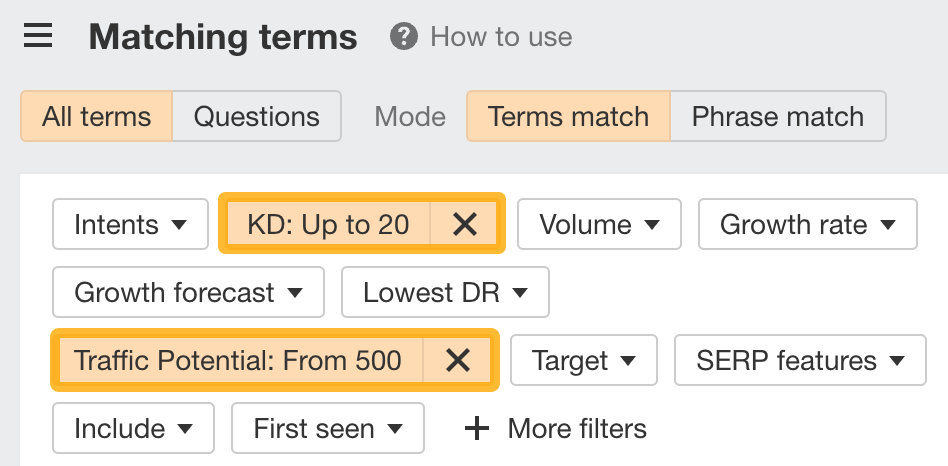
When you have your list of desired keywords, you’ll have to create content to rank for them. Doing this means understanding why the searcher is looking for that topic.
You can figure that out by looking at what’s currently ranking in the SERPs for the target topic. The easiest way to do this is click on the SERP button for your target keyword, click Identify intents, and it’ll tell you the search intent for that topic.
For example, here’s what we see for “best coffee maker”:
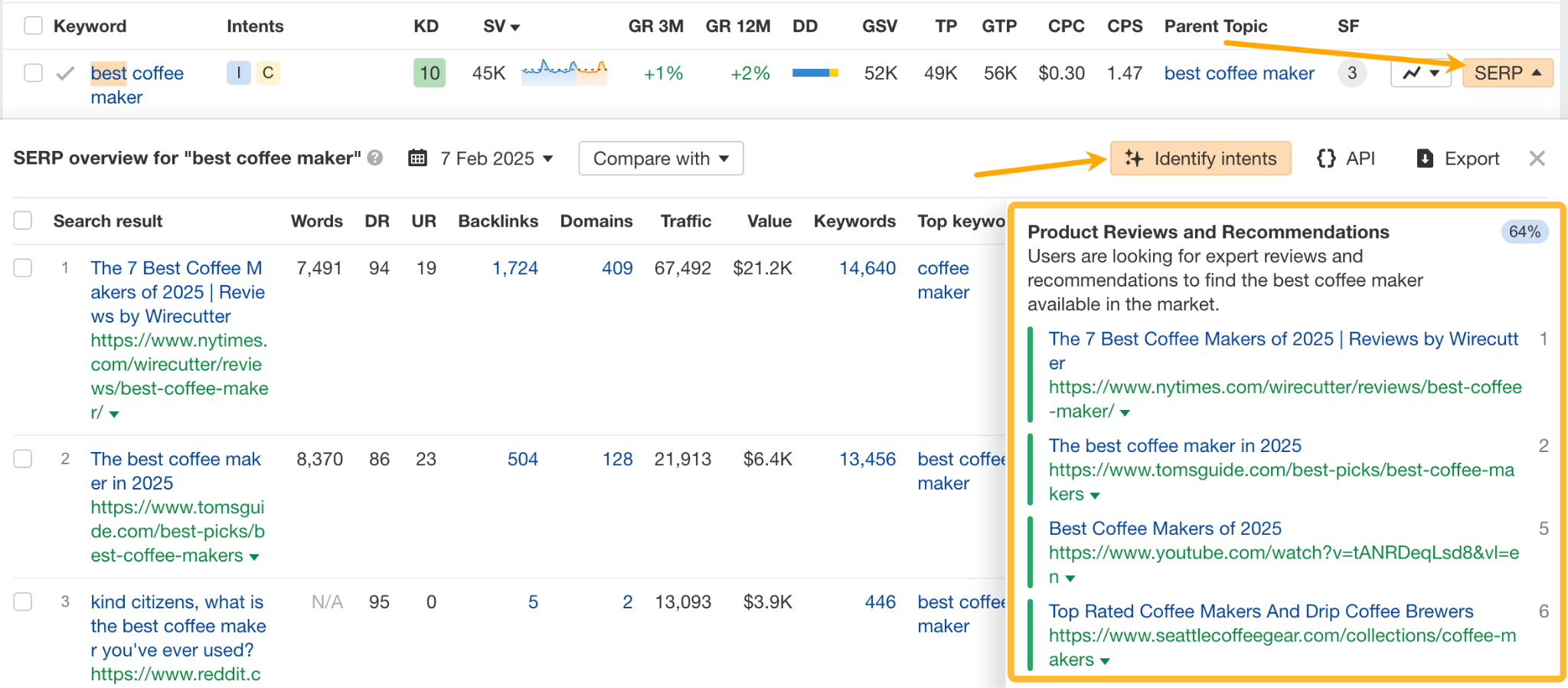
Searchers are looking for expert reviews and recommendations for the best coffee makers. So, you’ll likely have to create something along those lines if you want to rank high for this keyword.
Finally, you’ll have to get links to your pages. Links are a Google ranking factor, and even though Google reps have said that they matter less these days, they still matter (according to our research.)
There are many ways to acquire backlinks, so I recommend reading our guide to link building.
YouTube
You may not realize it, but YouTube is the second-largest search engine in the world. YouTube has 2.49 billion monthly active users and people spend an average of 48.7 minutes on YouTube each day.
Sam Oh, our YouTube god, helped grow our channel to 608,000 subscribers.

Last year, he shared some of his YouTube tips at our inaugural conference, Ahrefs Evolve.

Here are his best tips for ranking high on YouTube:
- Add target keyword to your title and description
- Mention relevant keywords in your content
- Cover necessary subtopics in your content
- Use timecodes or chapters with relevant keywords
- Hold people’s attention as long as possible
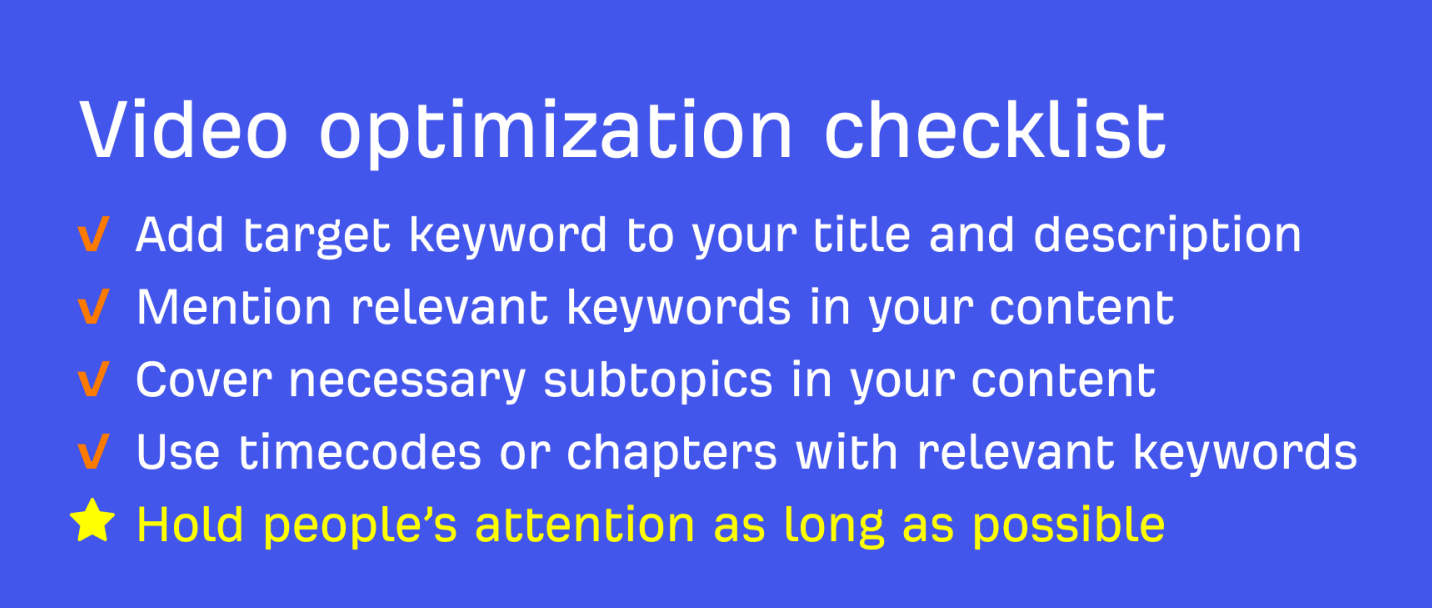
The last one is of course, the hardest. There is no sure formula and even at 600K subscribers, we’re still constantly experimenting to find the best-fit format that our subscribers will watch to the end. So, as Sam says, aim to improve your videos by 5% each time.
For example, we make a variety of thumbnails for each video and swap them out if one of them isn’t working:

Thumbnails for one of our videos
However, one thing’s certain: You’ll have to capture your audience’s attention within 30 seconds. Otherwise, they’ll drop off, never to return.
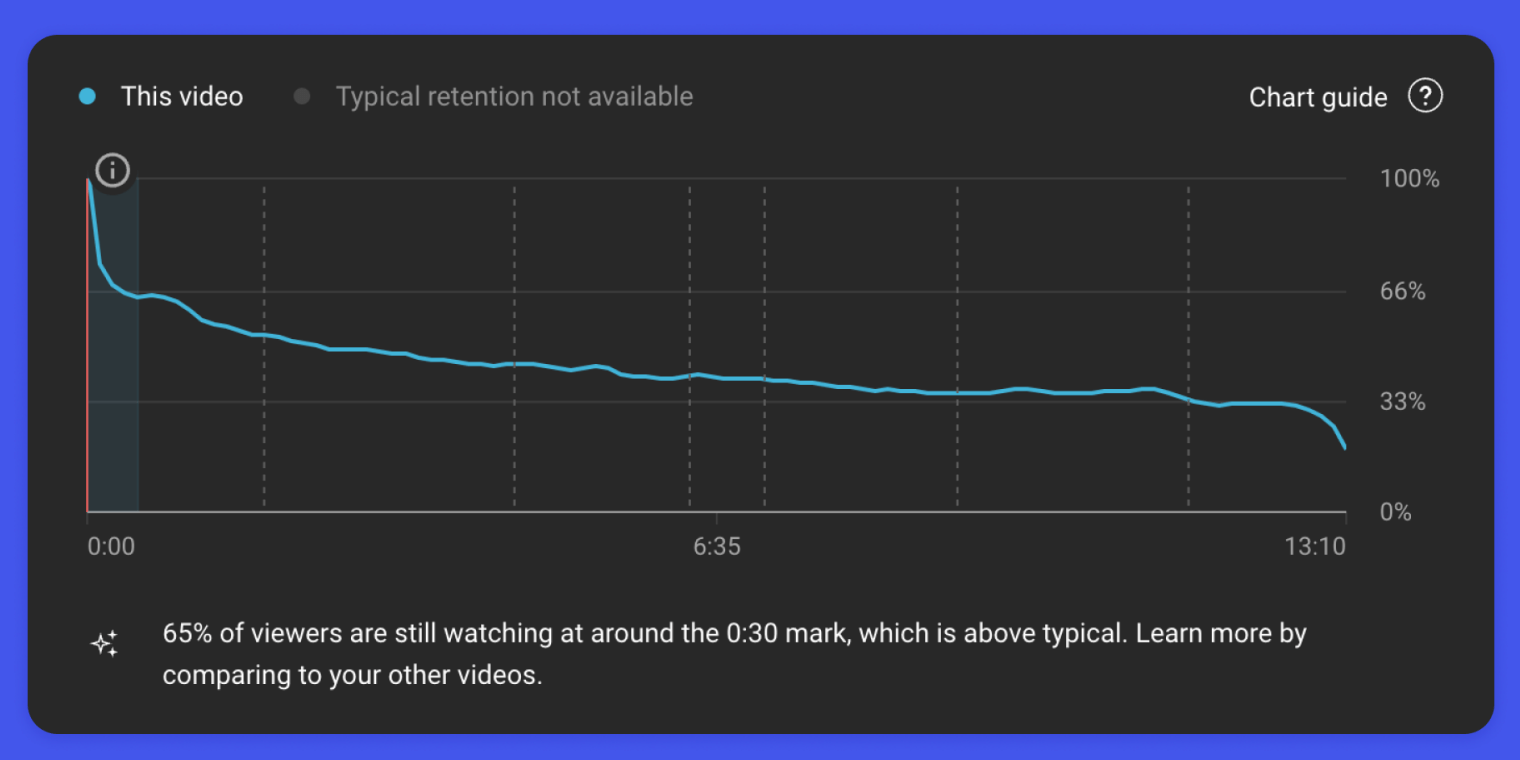
ChatGPT and other LLMs
More and more people are turning to large language models to answer questions, get recommendations, and acquire advice. Some LLMs, like ChatGPT, Perplexity, and DeepSeek, can search the web, effectively transforming into an AI search engine.
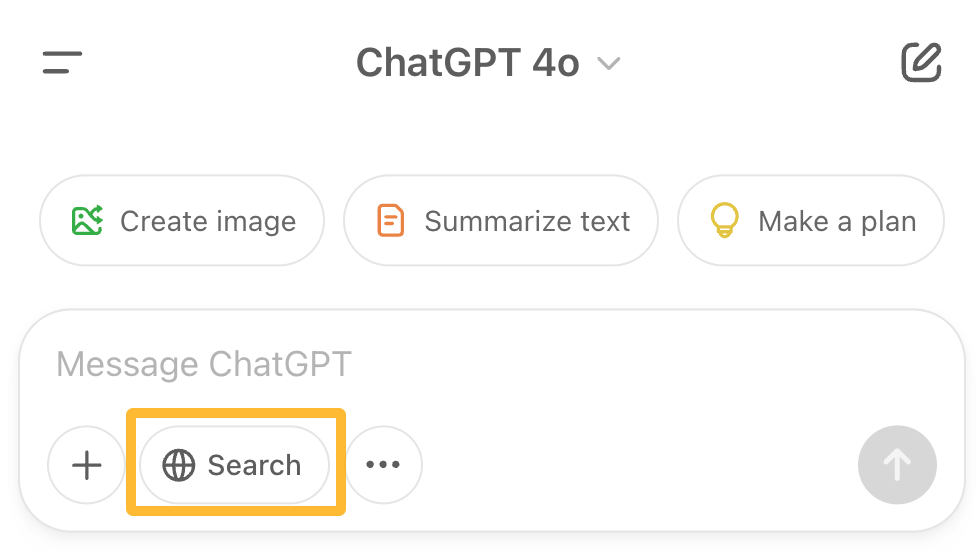
As such, more brands are investing in LLM optimization (LLMO), trying to get LLMs to recommend their brands when relevant questions are asked.
We’ll soon be releasing an LLM Chatbot Explorer, which will include a full brand visibility report to benchmark performance and test the impact of your LLM optimization.
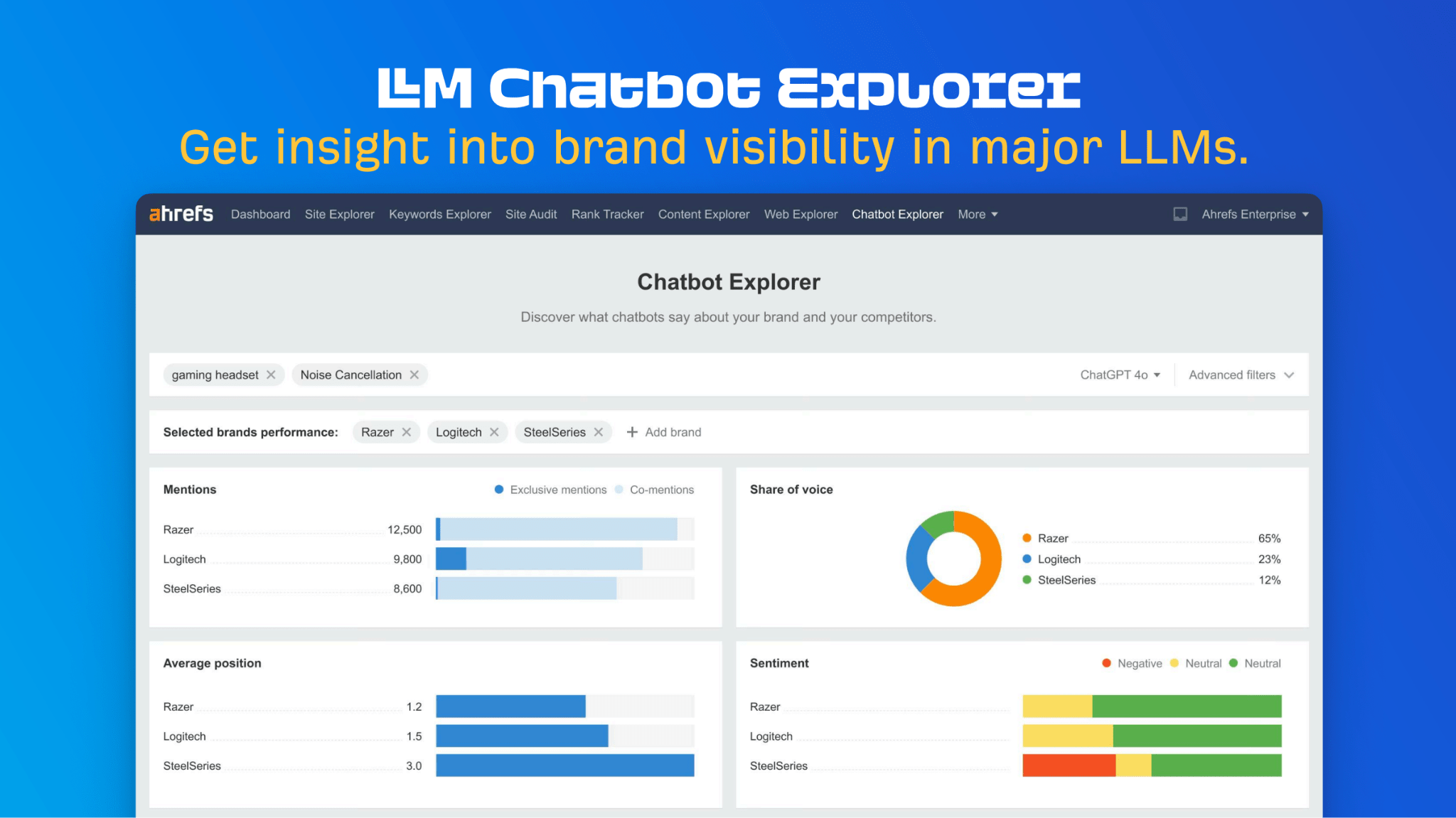
Some tips on LLMO include investing in PR, adding more quotes and stats to your content, doing entity SEO, and claiming your Wikipedia listing.
One thing to note is that LLMO and SEO are closely linked. A study from Seer Interactive suggests that organic rankings do drive LLM mentions. So, even if LLMs are the future of search engines, don’t neglect your SEO.
My colleague Louise has written an amazing guide on LLMO, so I recommend reading it from start to finish.
TikTok and Instagram
Banned or not, there is no doubt that the short-form video platform is the social media of choice for the younger generation and beyond. (Heck, even my dad uses it.)
In fact, a 2024 study by Adobe suggested that 2 in 5 Americans use TikTok as a search engine and 1 in 10 Gen Zers are more likely to rely on TikTok than Google as a search engine.
The same goes for Instagram.
In our conference last year, one of our speakers, Charlotte Ang, shared some tips on how to optimize for TikTok search:
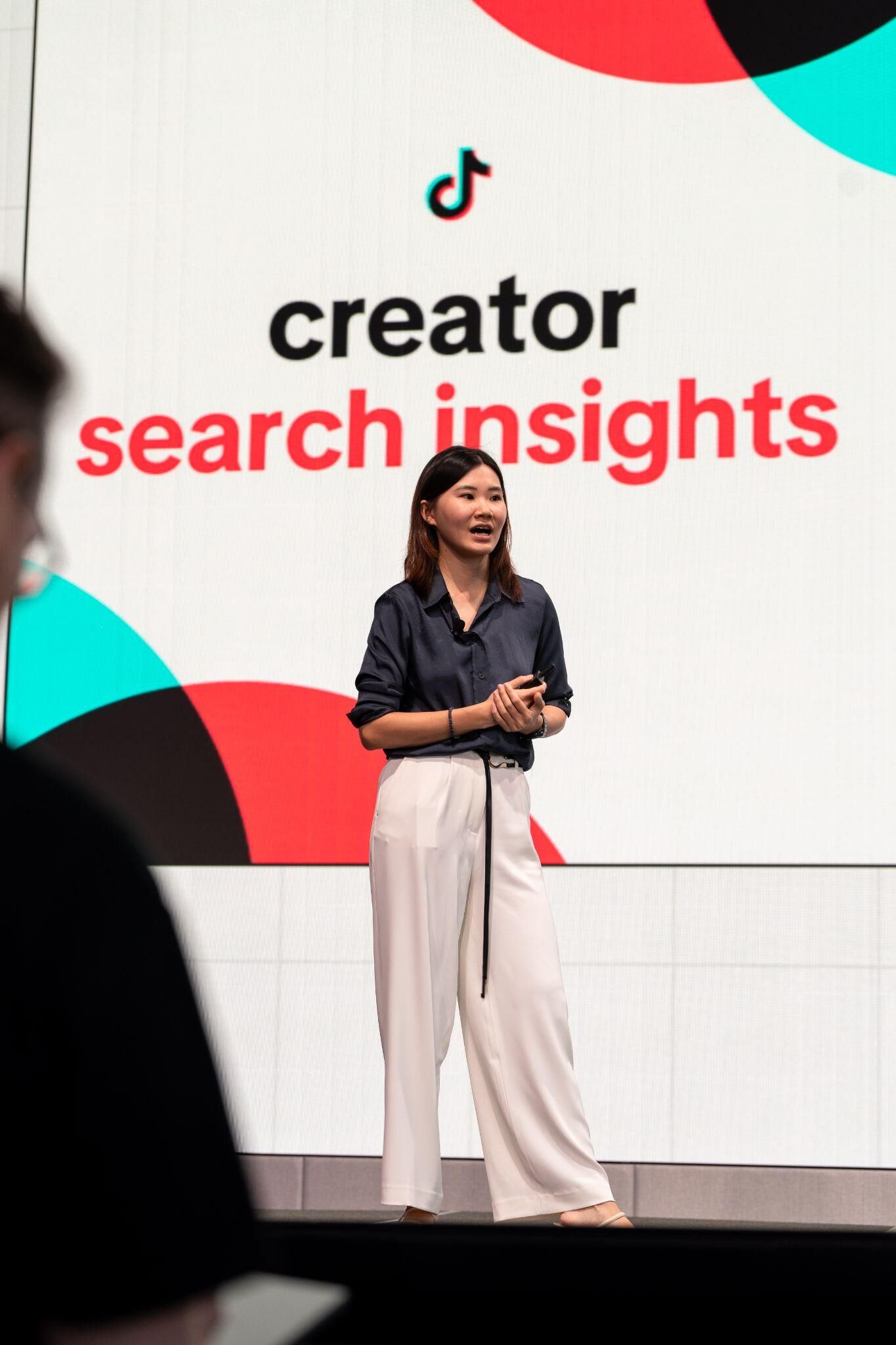
- Use Ahrefs’ Keywords Explorer to look for topic ideas (what you’ll do if you’re doing keyword research for SEO; see the section on Google/Bing)
- Look for relevant subtopics by checking TikTok’s auto-complete (during search) and Others search for
- Include a 5-second hook in all your videos
- Optimize your on-feed SEO by editing auto-captions accurately, including 3 related keywords, and use 3-7 hashtags.
- Post your video through Creator Search Insights
- Reply comments on your videos with your target keywords
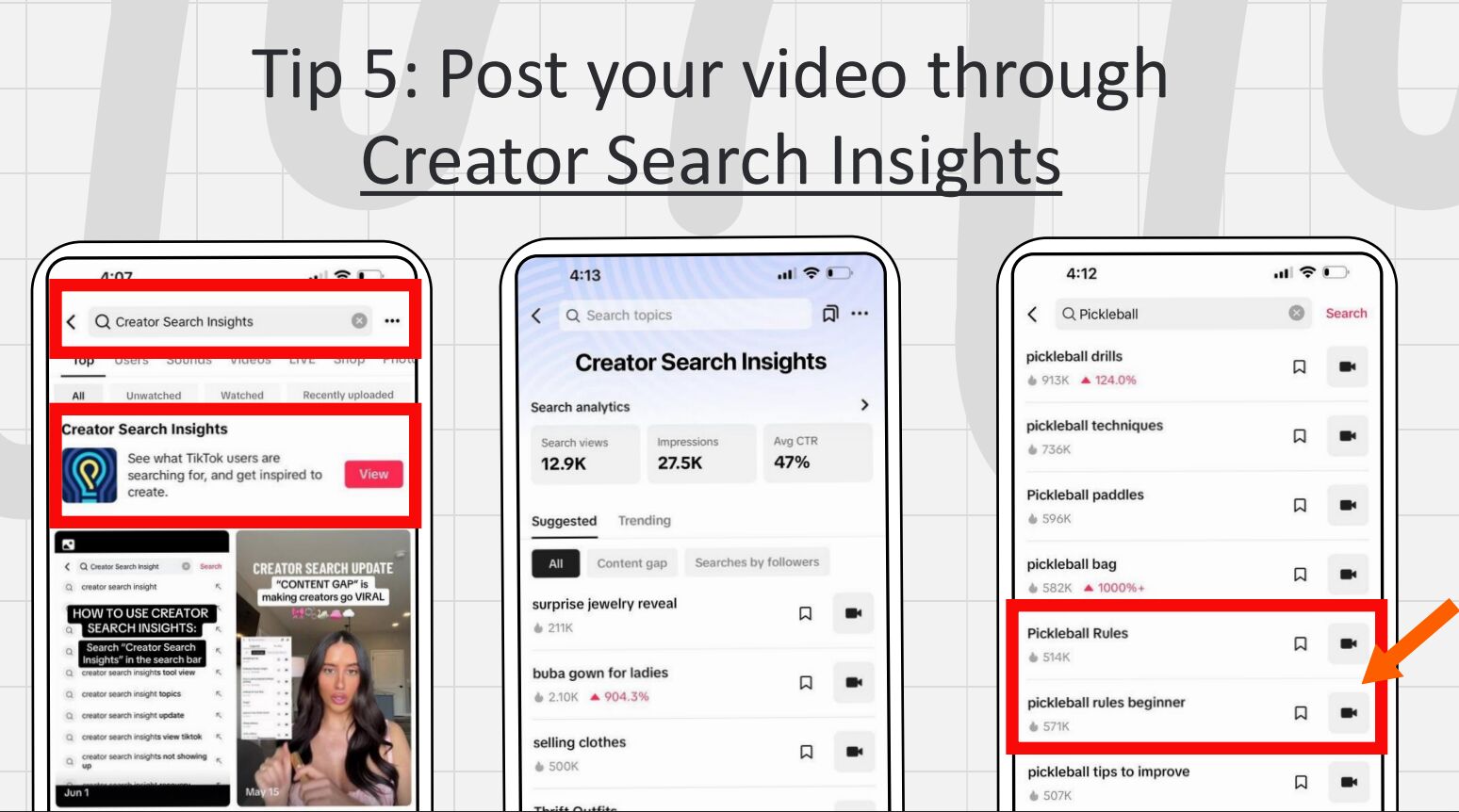
While there are some platform differences, you can likely do the same for IG too.
Pay a platform or someone with an audience to access their audience.
The opportunities to advertise your business are limitless. Just make sure you’re not spending $100 to acquire a $50 customer.
Here are the major advertising channels:
Google, Facebook, X, and other social media ads
Most of these platforms work the same way—you pay a fee each time someone clicks your ad on the platform. This is known as PPC marketing.
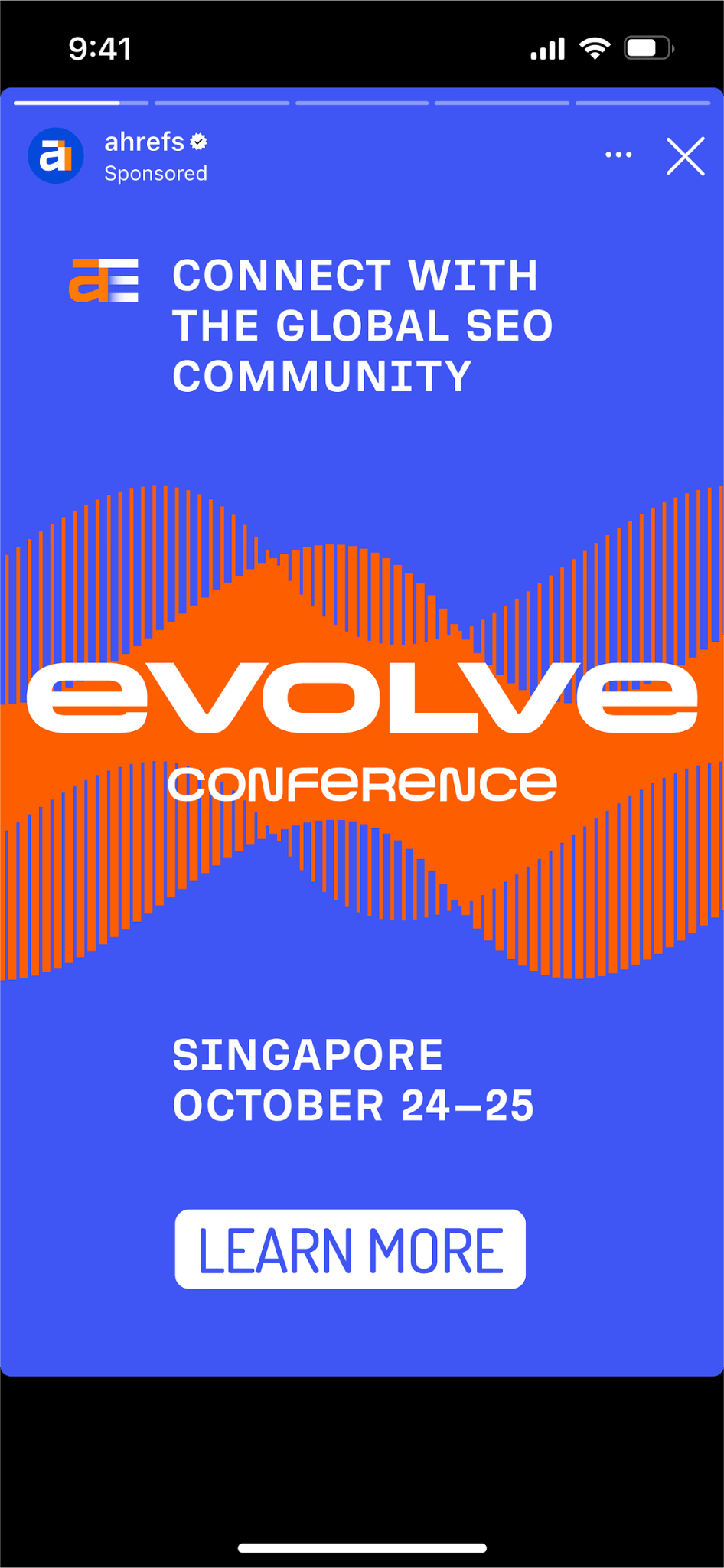
Our IG story ad promoting Ahrefs Evolve
First, you’ll need to choose a platform to advertise on. You should only run ads on platforms where your audience exists. For example, if you’re selling enterprise software, you might not want to advertise on TikTok (unless you have data that shows C-level executives in your industry are doomscrolling.)
Then, get familiar with the platform. Click around or take a course. Most of these platforms offer educational resources to help you learn. For example, Google offers free ads training:
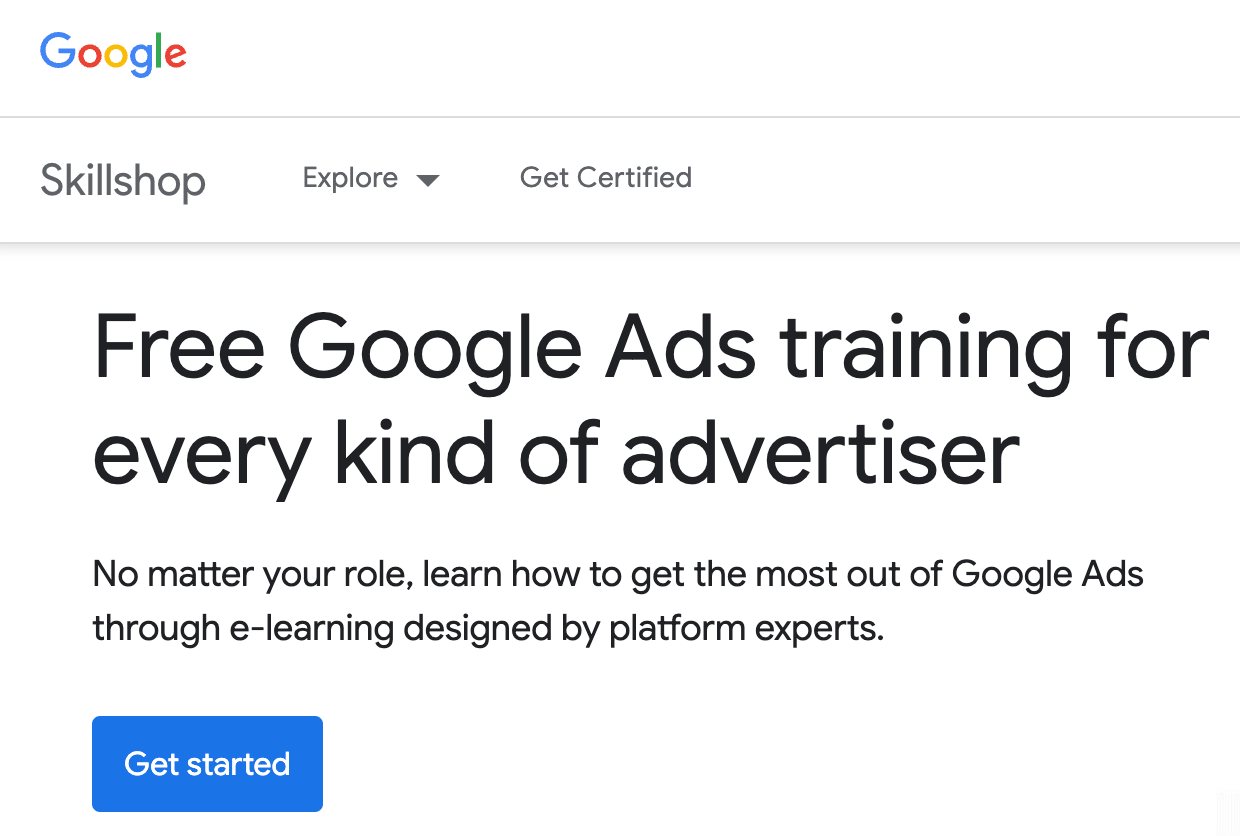
One of the most important aspects of PPC marketing is targeting. So, make sure you’re targeting the right audience on these platforms. For example, if you’re running search ads, one way to find the right keywords to target is to look at what your competitors are already running ads for.
You can do this by entering your competitor’s domain into Site Explorer and going to the Paid keywords report.
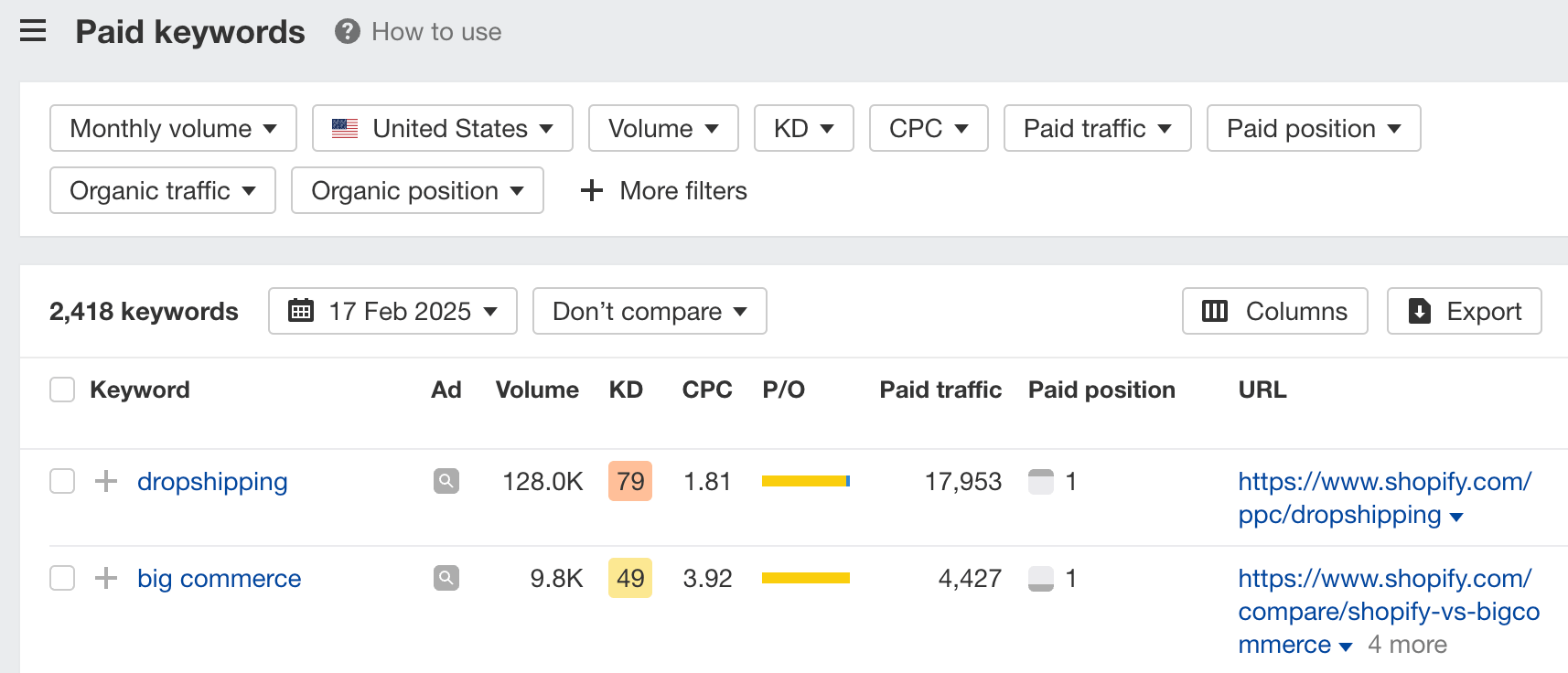
For example, we can see that Shopify is targeting the keyword “dropshipping” and paying an estimated $1.81 per click for the keyword. If you’re a competitor, you could potentially target the same keyword too (as long as the budget makes sense.)
Finally, creatives and copy matter a lot in PPC marketing. So, make sure you’re constantly experimenting with different images, videos, headlines, body copies, and more to see what resonates with your audience!
TV and out-of-home (OOH) advertising
We all know TV ads. But what are out-of-home ads? They’re what you see on the go, like billboards, transit (e.g., buses, taxis), and street ads.
OOH ads are typically expensive and large-scale. So, that’s why according to Adam Singer, VP of Marketing at AdQuick, an OOH ad platform, companies should start with a geofenced test campaign in a specific city. Then, by tracking metrics such as search volume uplift, website traffic, and brand awareness, you can decide if you want to run your OOH ads in more places.
Tim Soulo, our Chief Marketing Officer, interviewed Adam Singer on our podcast to learn more about offline advertising. Check out the interview:
Podcast advertising
With over 4.19 million podcasts in the world, chances are your audience is listening to one of them.
We regularly sponsor podcasts at Ahrefs. (We even run our own!) Generally speaking, there are three types of podcast sponsorships:
- Pre‐roll: ~15–30-second ad at the start of the show.
- Mid‐roll: ~1-minute ad in the middle of the show.
- Post‐roll: ~15–30-second ad at the end of the show.
Mid-rolls are the most expensive, followed by pre and post‐rolls.
Podcast sponsorships are a bit of a wild market, where pricing is arbitrary. You should expect to negotiate a lot. For example, you could potentially negotiate the price per episode to be lower if you’re looking to sponsor for a long period.
The one thing we’ve found that worked really well for us is getting the host to give an organic mention, rather than a scripted one. We almost never give podcast hosts copy to read from. We just give them the topic, some key points, and let them do the rest. After all, it’s their audience, so they know the best way to communicate.
Partnerships and influencers
Podcasts are just one medium where influencers build their audience. They can also build audiences on email, social media, YouTube, and more. You can pay to access their audience on those platforms too.
For example, we partnered with SEO influencer Eli Schwartz to promote our latest tool, Web Analytics:
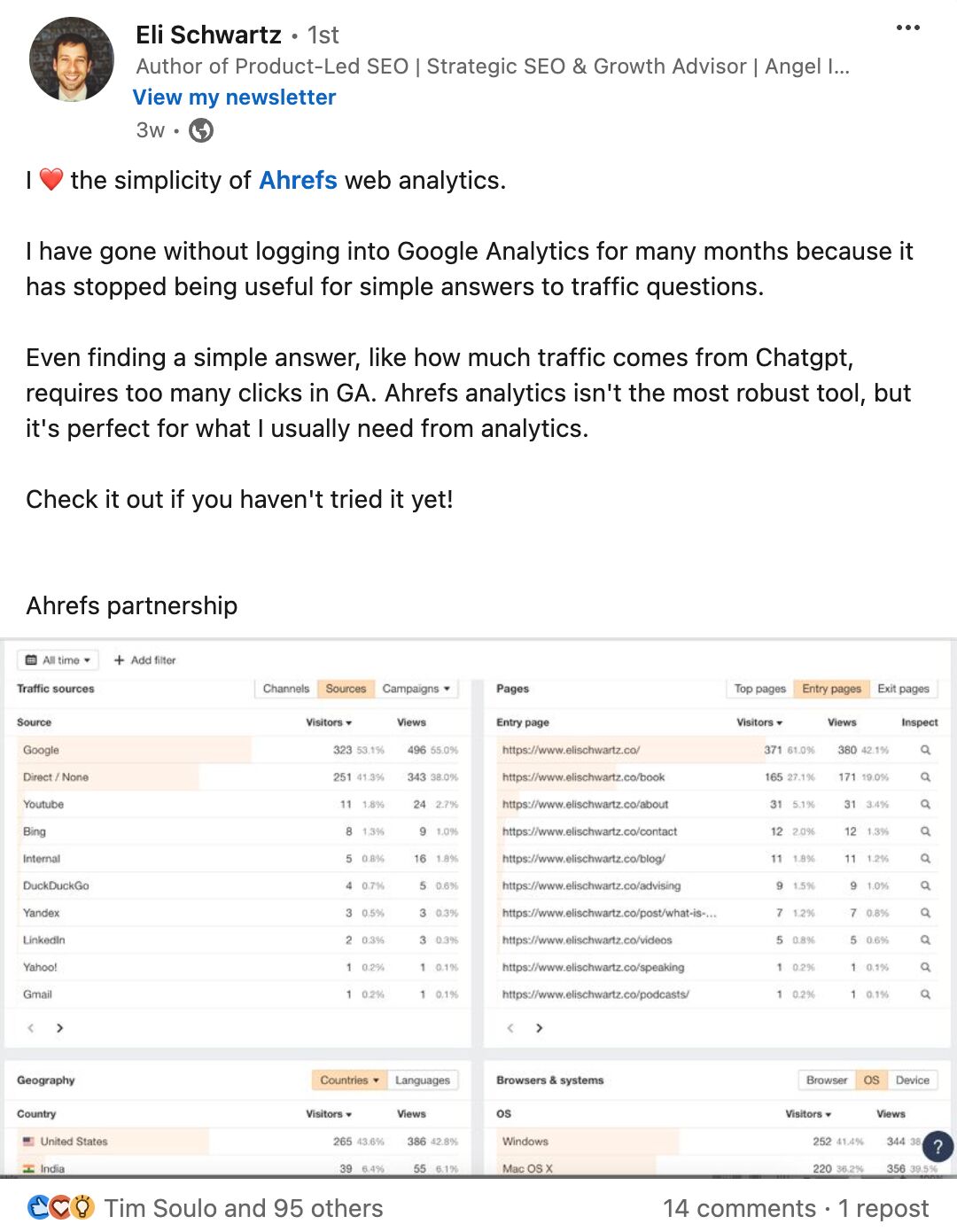
I asked Raúl Galera, Growth Lead at ReferralCandy, for tips on how to work successfully with influencers. Here’s what he said:
- Target smaller, more relevant influencers: This might seem obvious, but many brands still chase bigger names who may not align with their brand values or audience, simply due to their size. Instead, focus on niche or even micro-influencers who could genuinely be your customers—those who are popular but, more importantly, have an engaged and authentic community.
- Work on a performance basis: Offer influencers a deal where their payment is based (entirely or primarily) on the revenue they generate. Many influencers might not agree with this because their audience might not be as engaged as they claim. If they do agree, encourage them to see your brand as a team they’re part of rather than just another campaign.
- Be generous: A 10% commission won’t cut it. If possible, offer 20-25% or create a tiered commission structure. You could also consider giving commissions on the lifetime revenue generated by the customers they bring in, not just their first purchase. This keeps them motivated to consistently talk about your brand over the long term. How much are you spending on Meta ads? Use that as a benchmark—chances are influencer marketing will cost you far less.”
Affiliates
Affiliate marketing is where you give content creators a special link with a tracking ID. People who click on that link gets a cookie stored on their device.
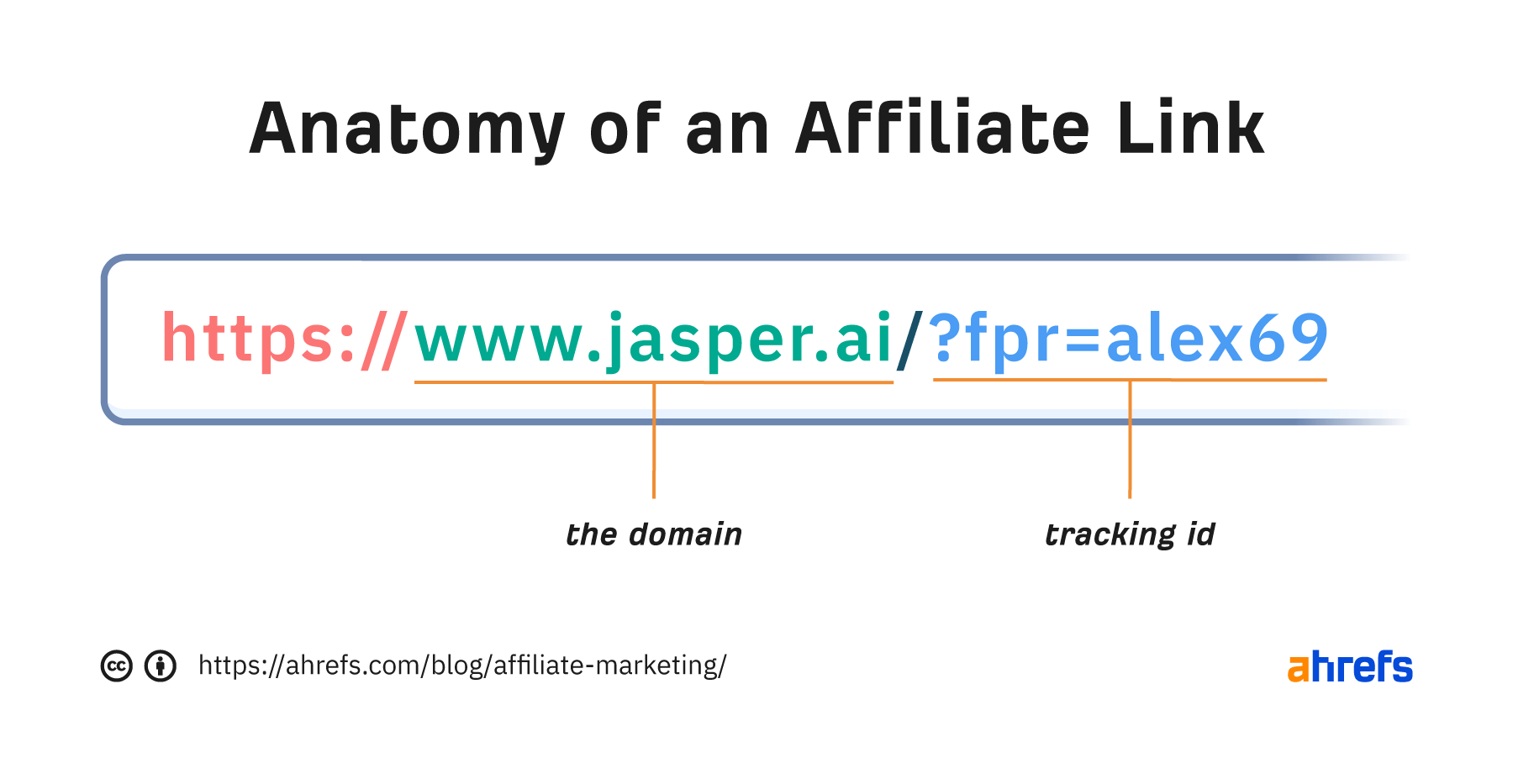
If they end up purchasing from your website, the sale is attributed to the content creator’s link and you pay them a commission from the sale.
In the best-case scenario, imagine hundreds or thousands of salespeople working round the clock to sell your product.
Because you’re paying commissions, the size of the commission could make or break your affiliate program. Ideally, it should be attractive enough but not so much that you lose money per sale. This probably depends on knowing your customer acquisition costs.
Getting the right affiliates is also important. There’s a fantasy that you’ll get thousands of affiliates rushing in when you open one, but it doesn’t work that way. Pareto’s Principle applies: Most affiliates don’t drive any sales, and the most successful ones tend to generate the bulk of the sales… and that lets them be discerning about who they partner with, and how much they charge (as they need to maintain their relationship with their audience.)
So, there is a lot of work involved in recruiting the right affiliates, from checking if their reputation is airtight to seeing how they’re going to promote your product. You may even have to step in to help them out with discounts and coupon codes.
Go after your target customers directly.
If your total addressable market (TAM) is small, the above two strategies may not work. Some businesses are so niche that they know most of their target customers by name.
But direct marketing also applies to your enterprise customers. It’s rare that major deals come solely from search or advertising. You’ll need the human touch too.
Here are the major activities in direct marketing:
Account-based marketing (ABM)
ABM is a type of B2B marketing that focuses on aligning marketing and sales to reach specific target accounts. As Marcus Ho, founder of Brew Interactive explains at Ahrefs Evolve 2024, ABM is like proposing to your top prospects:
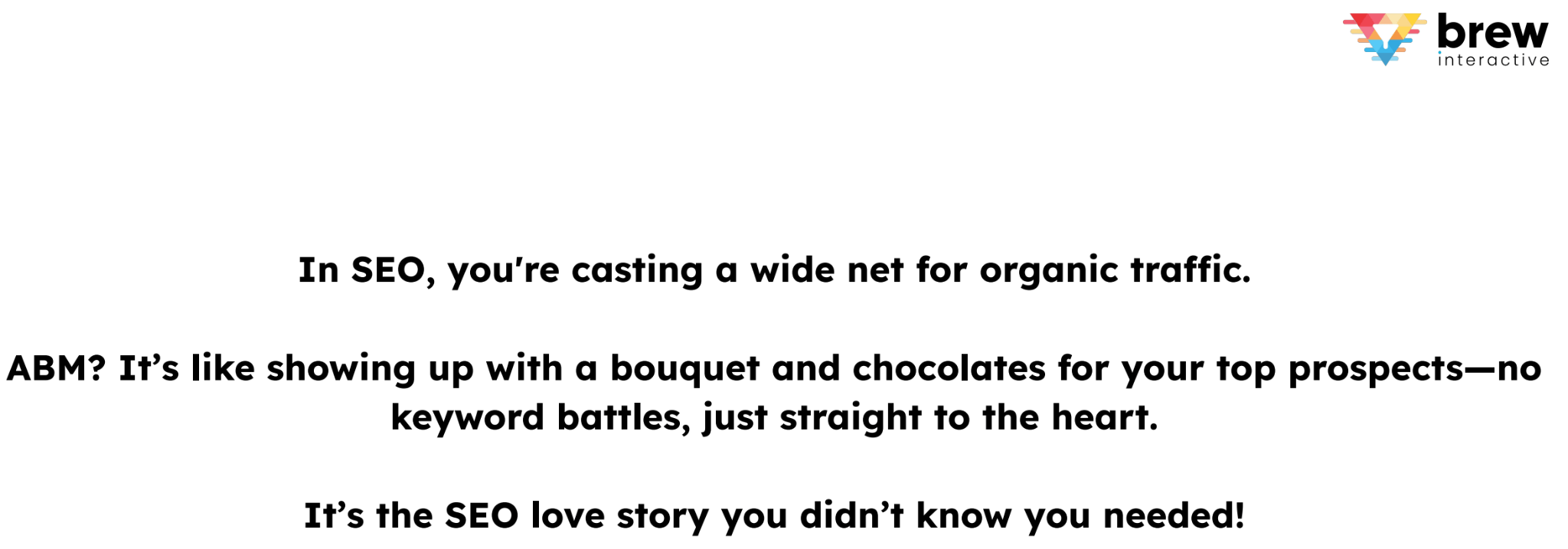
There are three types of ABM:
- One-to-one: Highly personalized marketing approach targeting a select few high-value accounts
- Balanced: Targeting mid-market with semi-personalized campaigns that can reach more accounts quickly.
- High-scale: Using automation with data-driven decision-making tech to target a wide range of accounts.
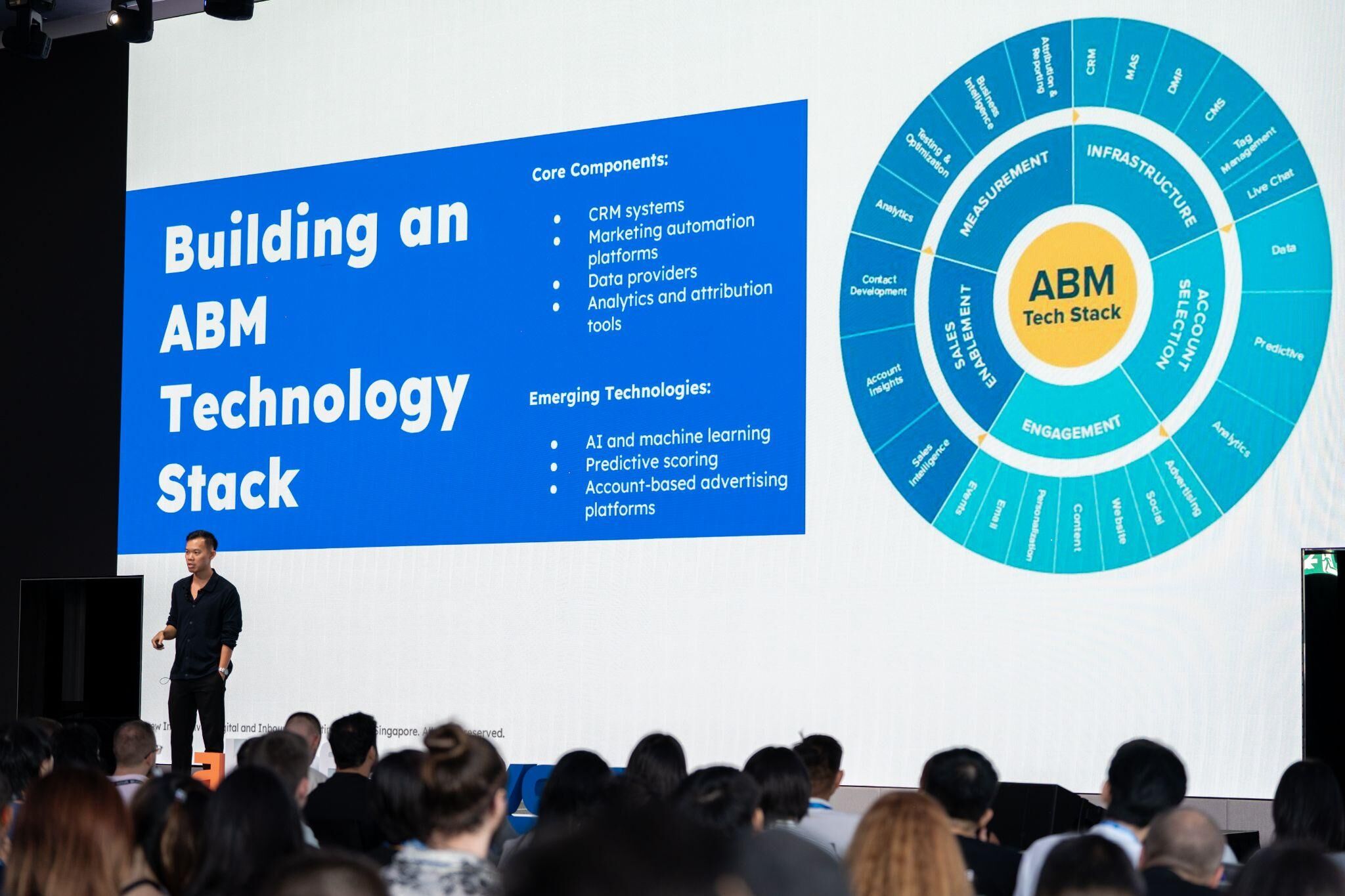
Knowing which strategy to use depends on your company’s goals. Most importantly, you need to know your ICP, like their industry, company size, revenue, pain points and challenges, buying behaviors, and decision-making processes:
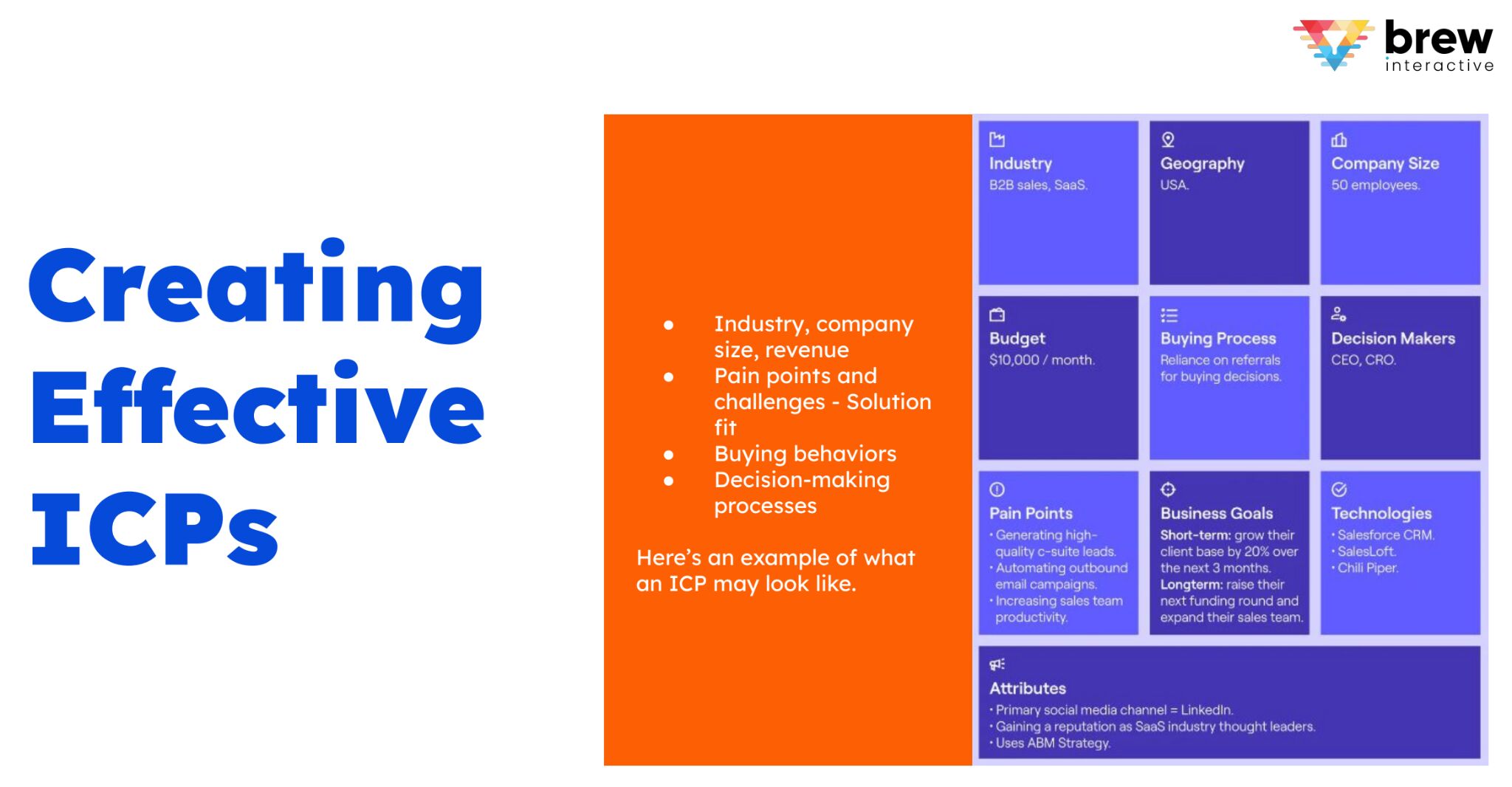
Once you’ve selected your accounts, it’s really about engaging them the right way.
For example, if they’re still at the Awareness stage, you’ll want to target them with advertising. If they’re in the Consideration stage, then you could invite them to one of your webinars. If they’re in the Purchase stage, then dedicate resources to getting them over the line, like customer stories and case studies, how-to guides, and more.
Event marketing
AI may do our work, but it can’t replace human interaction (yet).
Events are a great way to meet your prospects and customers, get to know them as people, learn from them, and maybe even do business together.
I mentioned it many times in this article, but we ran our inaugural conference, Ahrefs Evolve, in 2024 and will be doing it again in 2025.
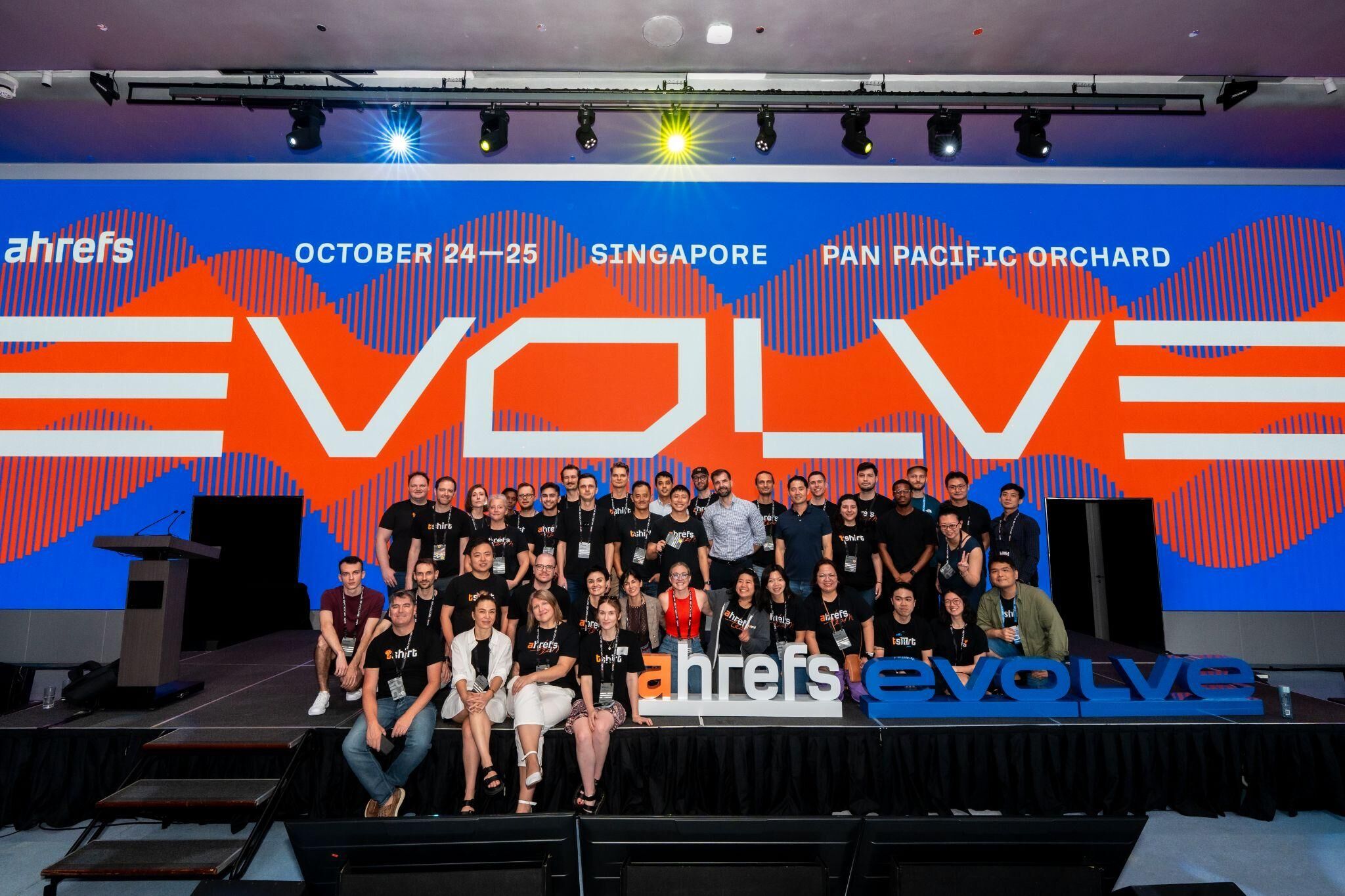
But the conference isn’t the only event we’ve run; we’re constantly running workshops, meetups, webinars, and more.
In fact, this is the route I recommend to anyone who wants to do event marketing: start small.
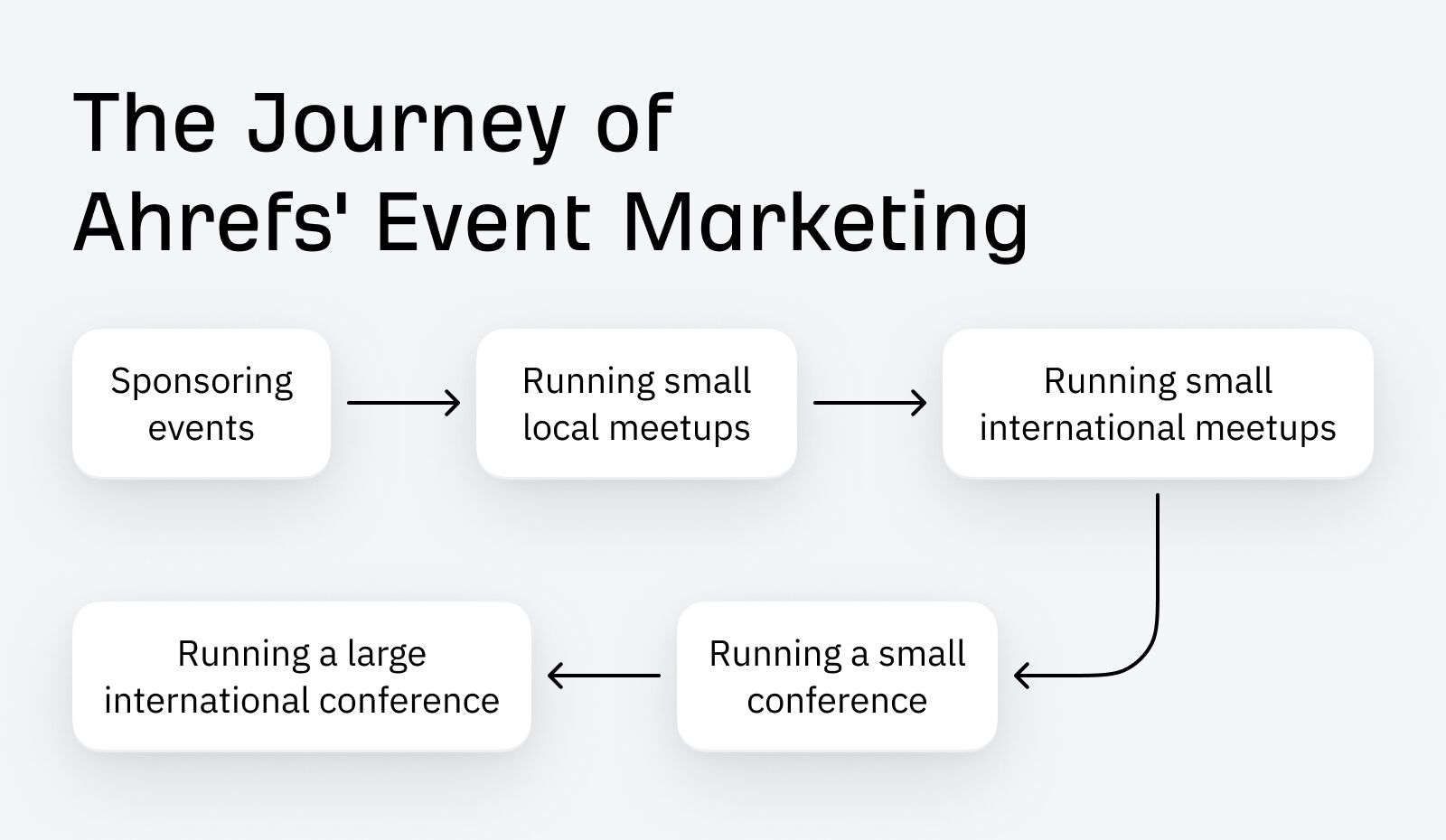
Don’t rush straight into a multi-day, international conference. Start by sponsoring some events or running small local meetups in your city. Only scale it up if you’re seeing traction or potential growth.
I wrote a guide with everything you need to know about event marketing. I highly recommend reading it if you’re planning on this channel.
People recommend your brand to their friends, family, and even online.
Word-of-mouth marketing happens naturally, but that doesn’t mean you can’t accelerate it with strategic marketing and equipping your customers with catchy talking points.
Here’s how:
Having an amazing product, content, and brand
Even if a restaurant offers you money to recommend them, you likely won’t do it if the food is terrible. You simply can’t put lipstick on a pig.
So it doesn’t matter what tactics you use—if you don’t have a product or service that solves your customers’ problems and delights them, no one will recommend you.
Your core focus should always be to make an amazing product and build a brand that your customers trust. For us at Ahrefs, that means:
- Consistently releasing new features, updates, and upgrades to our tool
- Creating tons of educational materials to help them get the most out of our toolset (including free courses, articles, YouTube videos)
- Listening to our customers when they have feature requests
- Monitoring conversations about our brand on social media and Reddit (and jumping in where necessary)
- Meeting our customers IRL at industry events and listening to their concerns
- Having a great support team

Me talking to our customers at Ahrefs Evolve
Little by little, all of these actions build up into a brand that our customers trust.
Building an audience
As you optimize for search and create content on multiple platforms, you’ll start to gain followers and build an audience. This is incredibly valuable as people on the platform can like or repost your post.
For example, Nat Eliason made >$400K in a few days just by announcing his course on X, where he has ~74K followers:
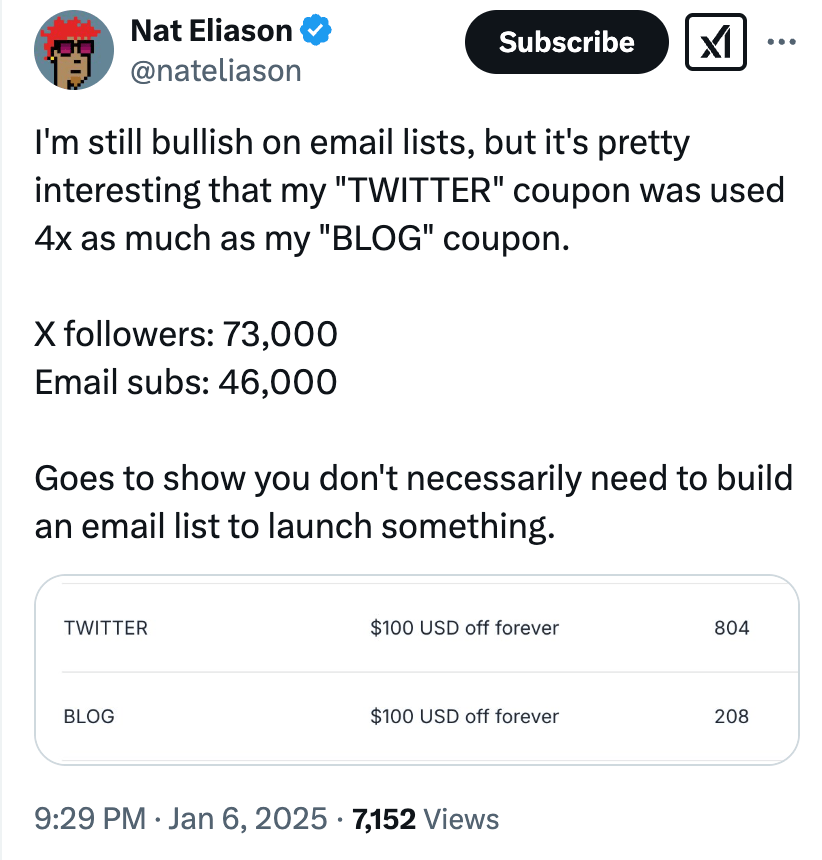
Even though Nat made the bulk of his revenue from his X audience, he’s still bullish on email lists. So am I. The main reason is that an email list is not subject to a platform’s algorithmic whims.
Your reach won’t be throttled when the platform changes algorithms or, worst case, bans your account. Even though your ‘virality potential’ is lower, with an email list, as long as your audience stays subscribed, you can reach them anytime.
So, even if you have a significant audience elsewhere, make sure you’re driving them to your email list frequently, like Justin Welsh:
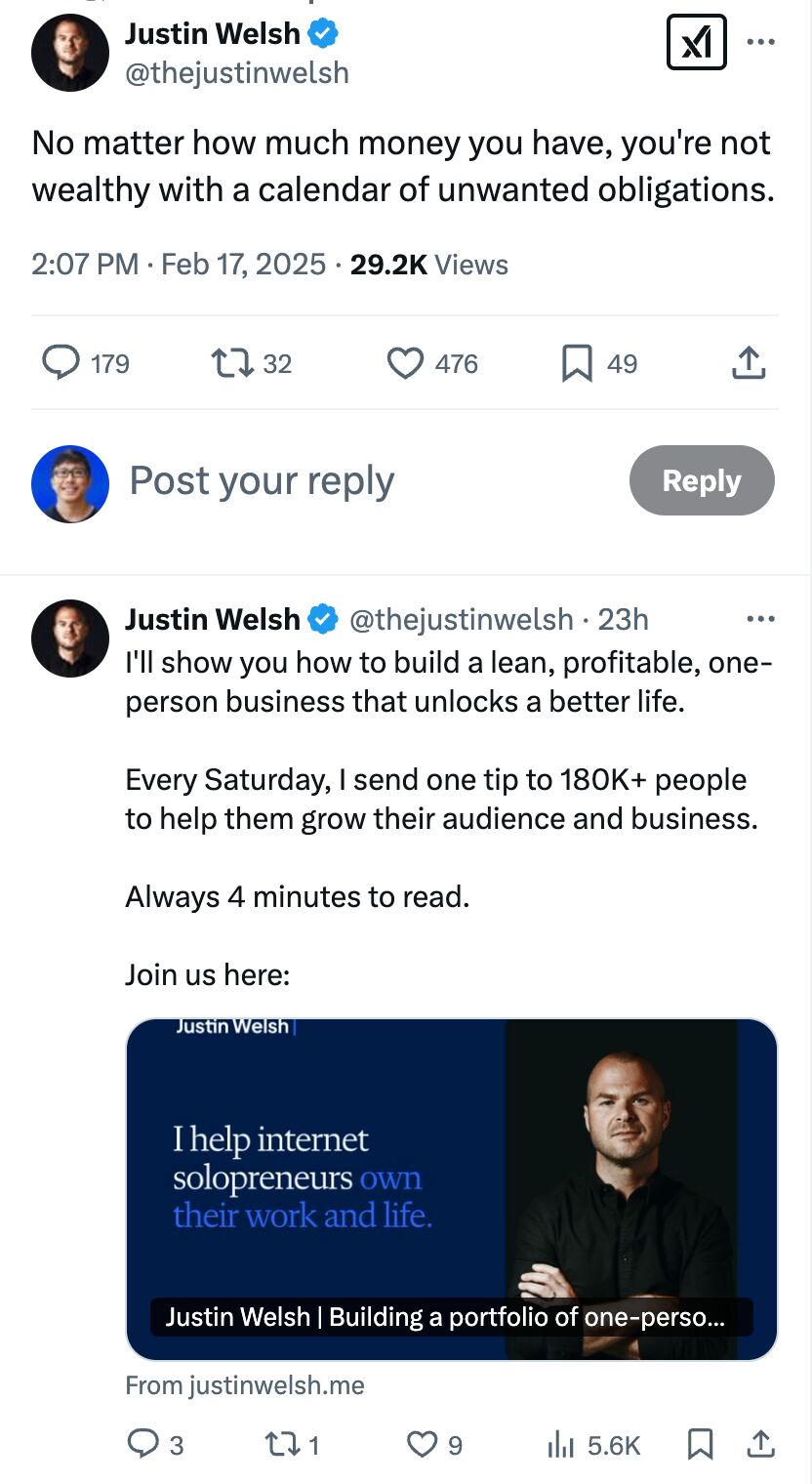
If the bulk of your traffic is going to your blog content, then make sure you encourage people to sign up, like we do on our sidebar:
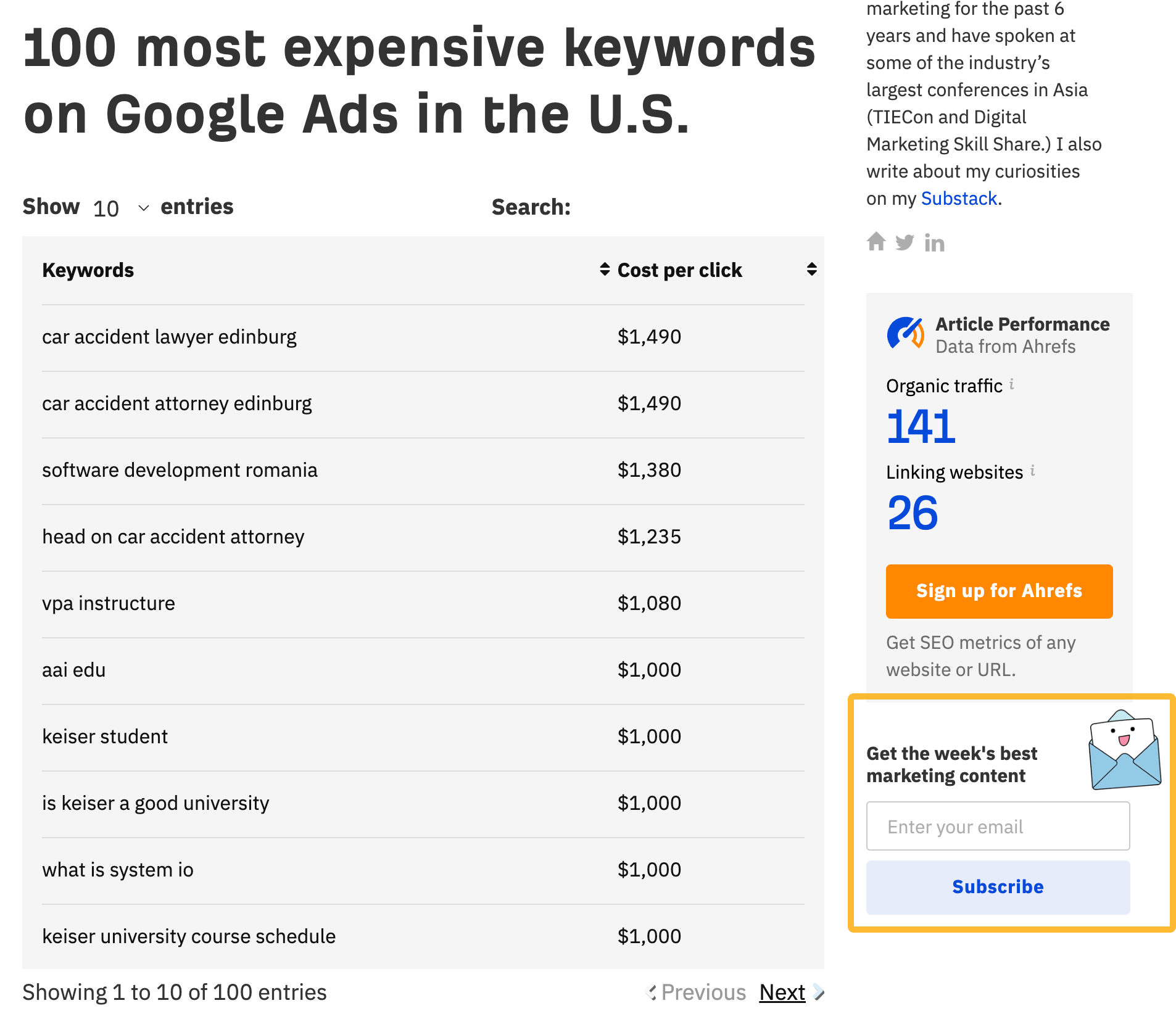
Giving away free stuff
‘Free’ is the easiest way to incentivize people to spread the word about your brand. Especially if you run a giveaway and package sharing into the criteria.
For example, we ran a giveaway to promote our conference. One of the “rules” of winning was to like and reshare the post:
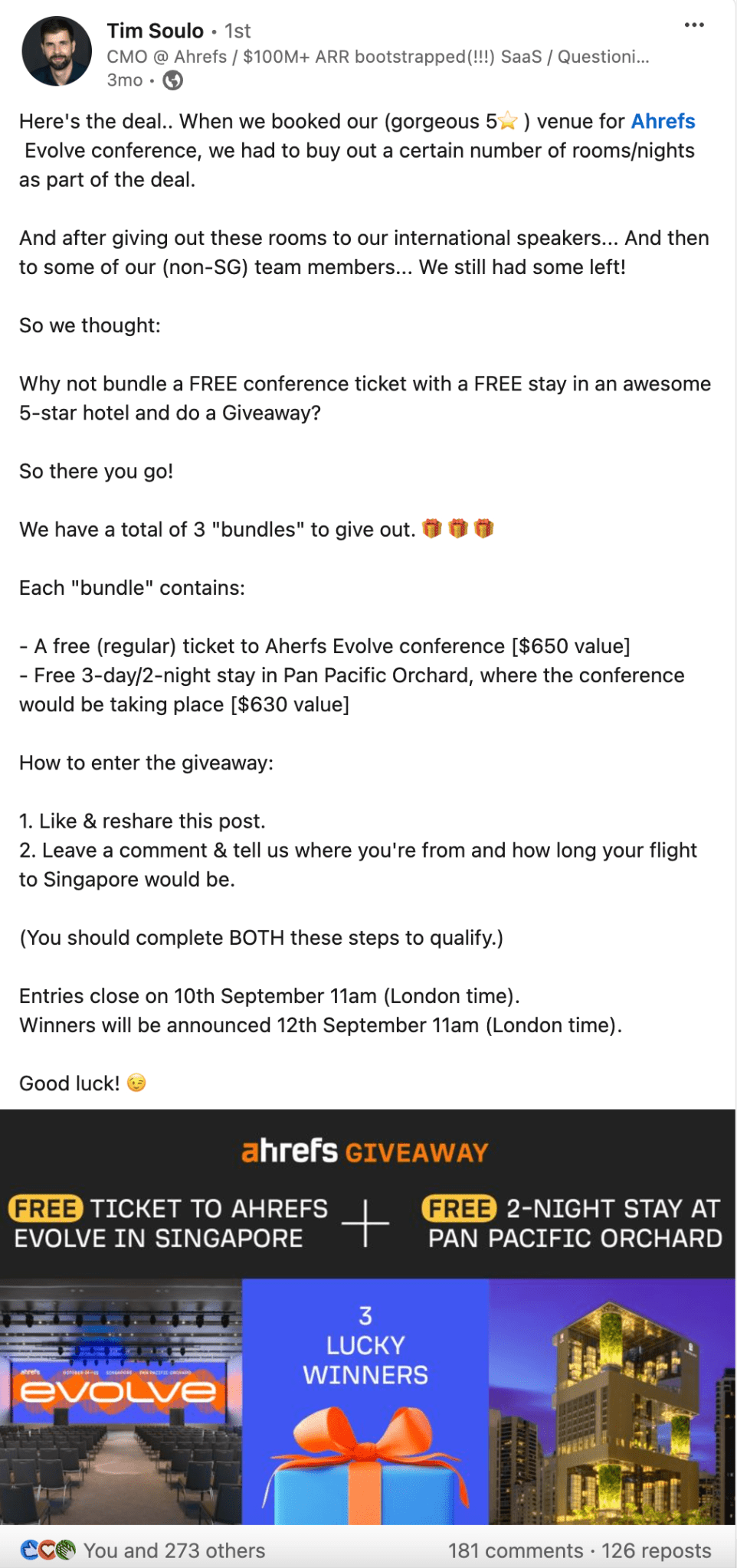
Even though you can probably gain a lot of attention by giving away expensive products like MacBooks and cars, I do not recommend doing that. Doing so will only gain you freebie seekers, and not your target audience. (Unless you indeed sell cars or computers.)
The best thing to give away is your product or something related to your product. For example, we regularly give away swag boxes and our SEO books:
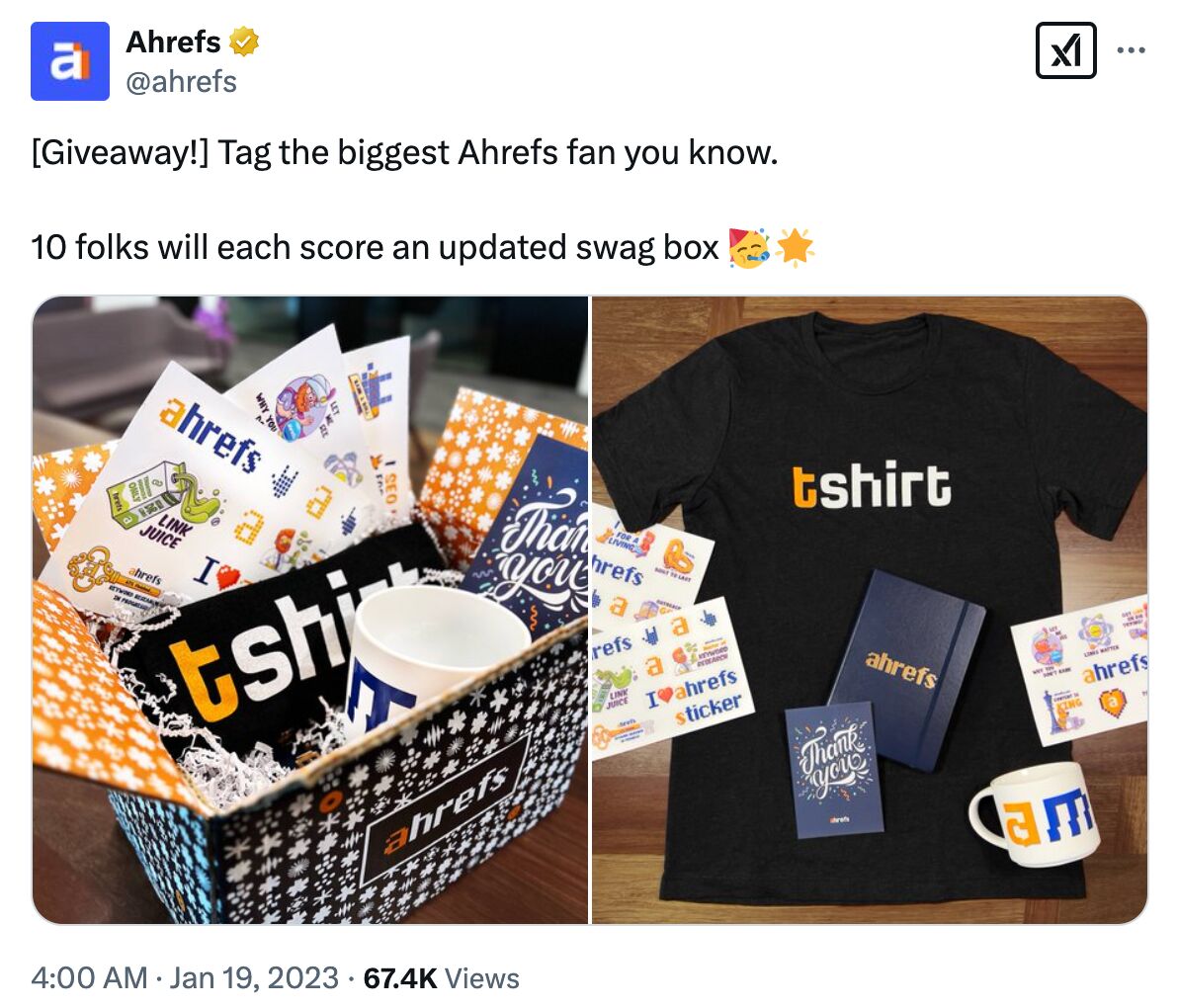
However, you don’t have to limit yourself to that. For example, years ago, when I worked for a startup without its own product (yet), we partnered with another company to give away theirs. We then shared the email list between ourselves.
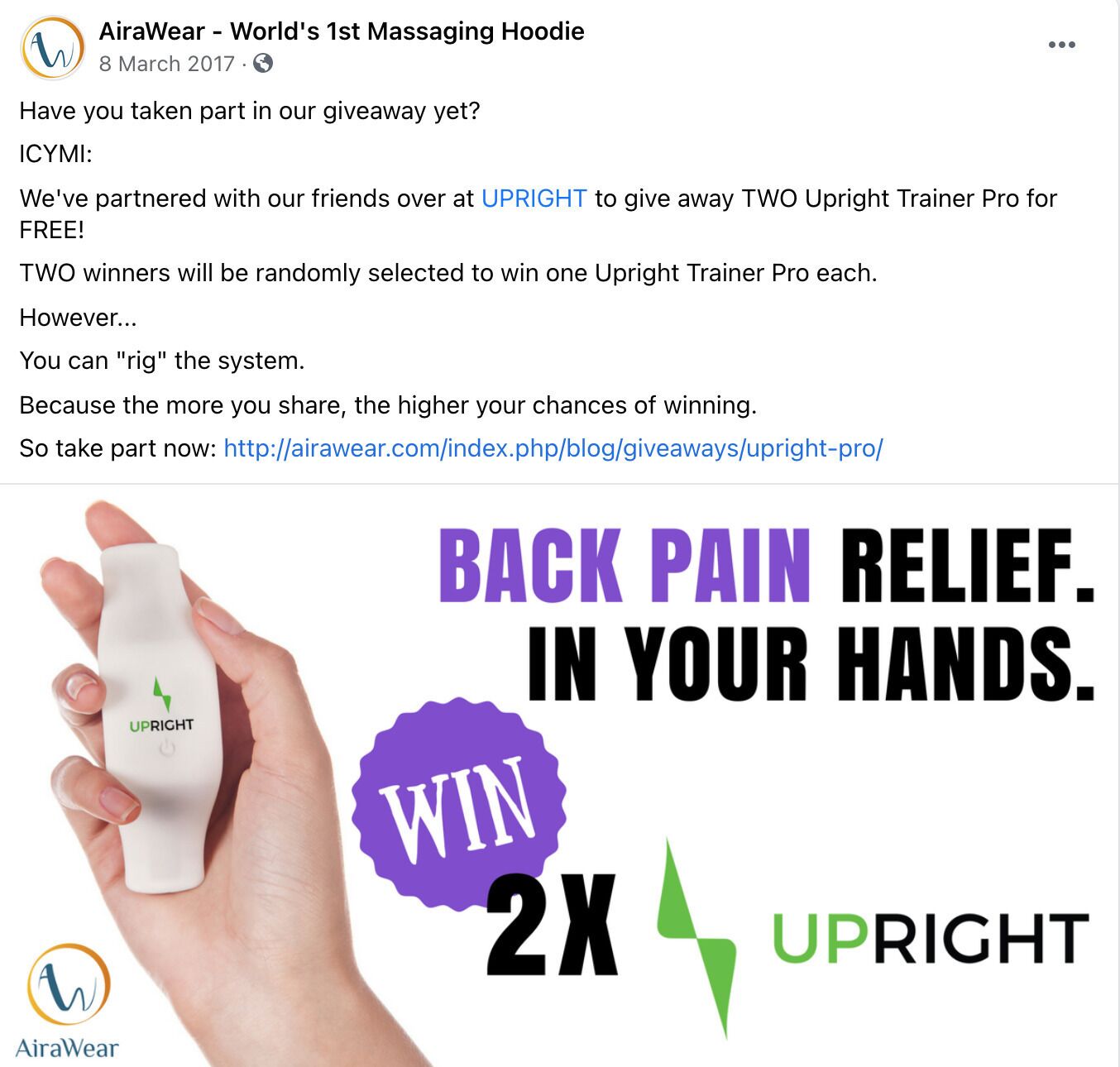
Public relations (PR)
Public relations is the practice of managing communications with the media. The goal is to influence your brand perception positively.
The main thing to know is that media publications are interested in what’s newsworthy. So, most PR tactics are either about jumping on what’s already trending or being the news itself.
For example, newsjacking is about monitoring live news and spotting opportunities to put your brand at the center of conversations by reacting with expert commentary and thought leadership pieces.
AskTraders consistently landed coverage in articles from big media houses by putting out expert commentary on everything happening in the business world: stock prices, company reports, administration news, and more:
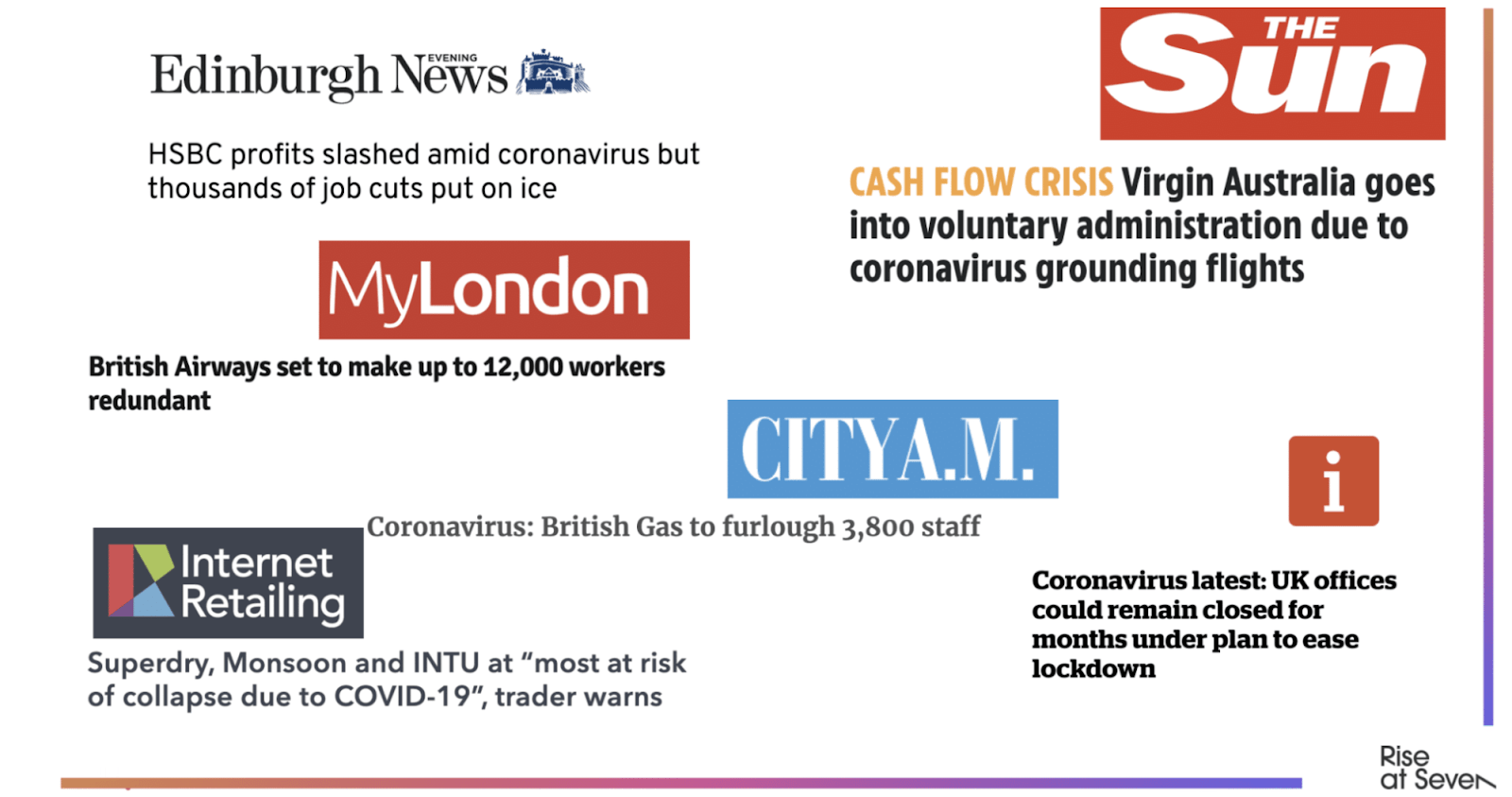
You can also aim to be the news itself. That’s where OOH advertising can help too. As Adam Singer points out in our podcast, a good OOH ad can get people talking and sharing on social media.
That’s also why companies sometimes run PR stunts to get people talking. For example, Circles.Life, a Singaporean telco, made the news by installing vending machines that dispensed a $50 note in exchange for $3.

You can hear Delbert Ty, ex-Head of Marketing of Circles.Life, discuss the campaign on the Ahrefs podcast:
To be fair, big stunts are not always necessary. Data is newsworthy too, so you can run surveys or analyze first-party/third-party data to generate interesting insights.
For example, real estate marketplace Zillow surveyed 1,815 homeowners and found that those with lower mortgage rates are twice as likely to stay put vs selling their home. They earned 235 backlinks from the likes of Bloomberg, Yahoo, FoxBusiness, and Money.com.
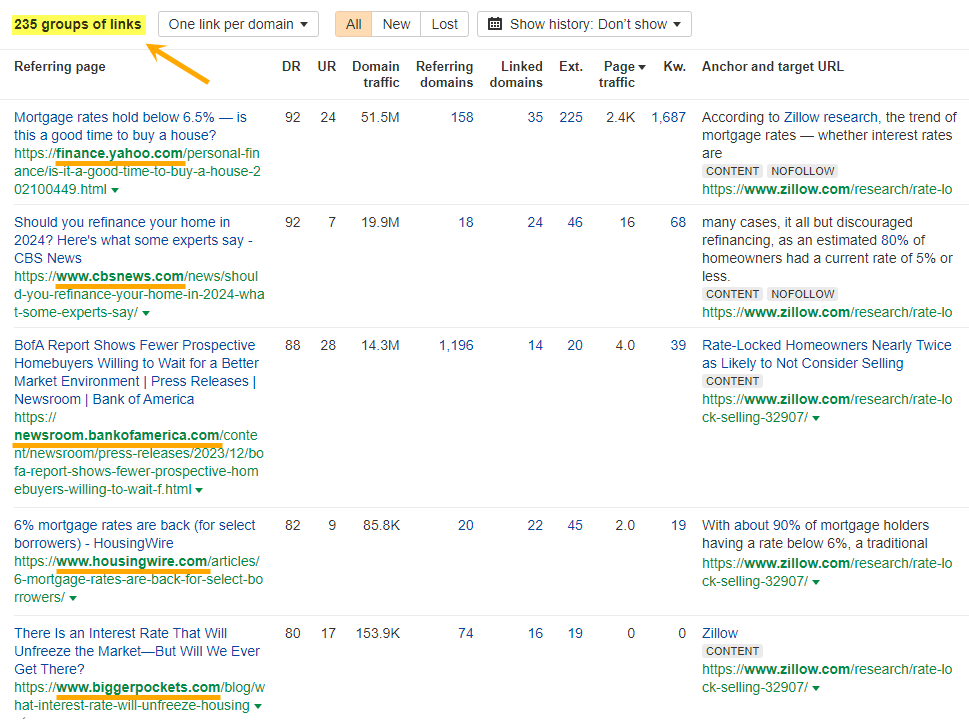
Final thoughts
Which customer acquisition strategy should you choose?
I learned this mental model from my friend, David Fallarme, who’s the VP of Marketing at Owner.com. The basic idea is to first know whether you’re going after elephants, deer, rabbits, mice, or flies (i.e. your business model):
- Elephants: 100 customers paying you $1m
- Deers: 1,000 customers paying you $100,000
- Rabbits: 10,000 customers paying you $10,000
- Mice: 100,000 customers paying you $1,000
- Flies: 1,000,000 customers paying you $100
When you know the animal you’re going after, then you can select the right hunting tools:
- Spears — Lots of direct human skill and involvement, e.g., direct marketing
- Nets — Lets you pull in a large number of potential targets at once, e.g, SEO
- Seeds — The customer base “grows on its own”, e.g., word-of-mouth
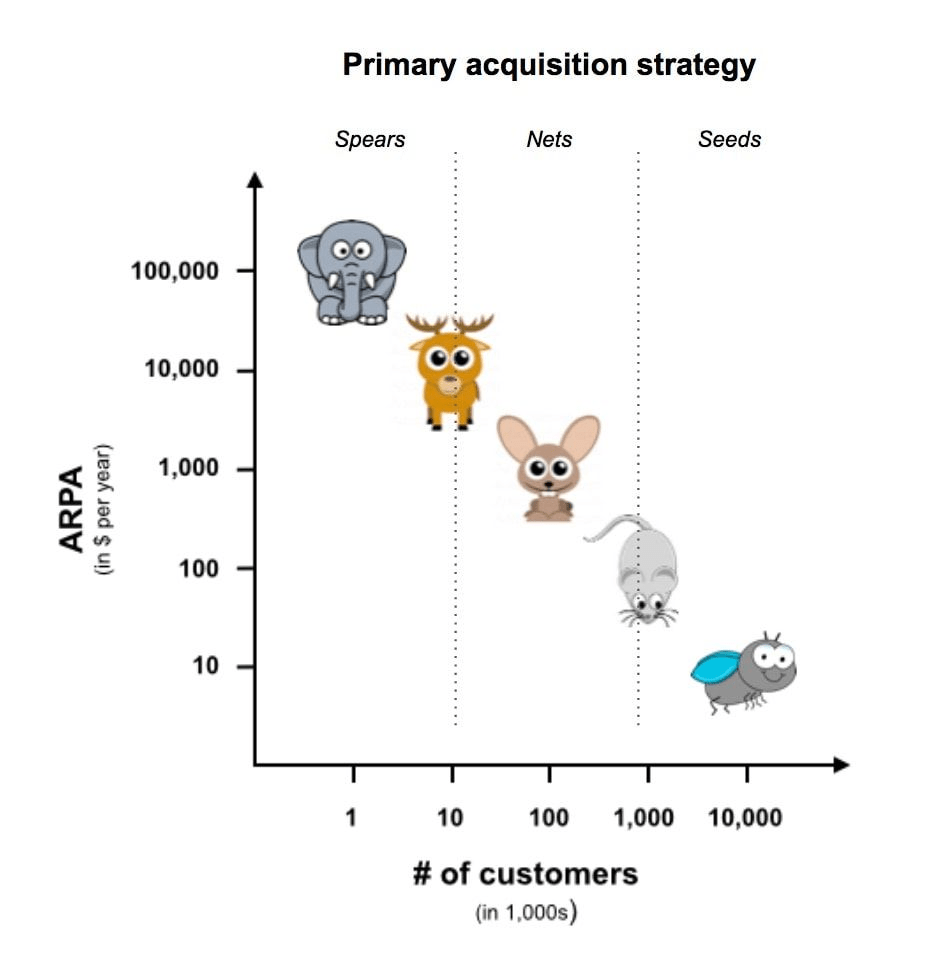
For example, in the earlier days at Ahrefs, we targeted mice, rabbits, and deer. That’s why our main customer acquisition strategy focused on search (“nets”)—we created content to rank high on Google and YouTube.
Today, as we move upmarket and target enterprise customers, we’re employing more direct marketing strategies. Running events and having an enterprise sales team (“spears”) are now also part of our arsenal.
So, which animal are you hunting?




